The Law of Insurance: Nuisance, Obligations, Delegated Underwriting, Insurance Cover, and Liability
VerifiedAdded on 2023/05/30
|25
|7516
|160
AI Summary
This article covers various topics related to the law of insurance, including nuisance, obligations, delegated underwriting, insurance cover, and liability. It also discusses how to handle insurance claims and the consequences of providing false information. The article provides examples and case studies to illustrate the different concepts.
Contribute Materials
Your contribution can guide someone’s learning journey. Share your
documents today.
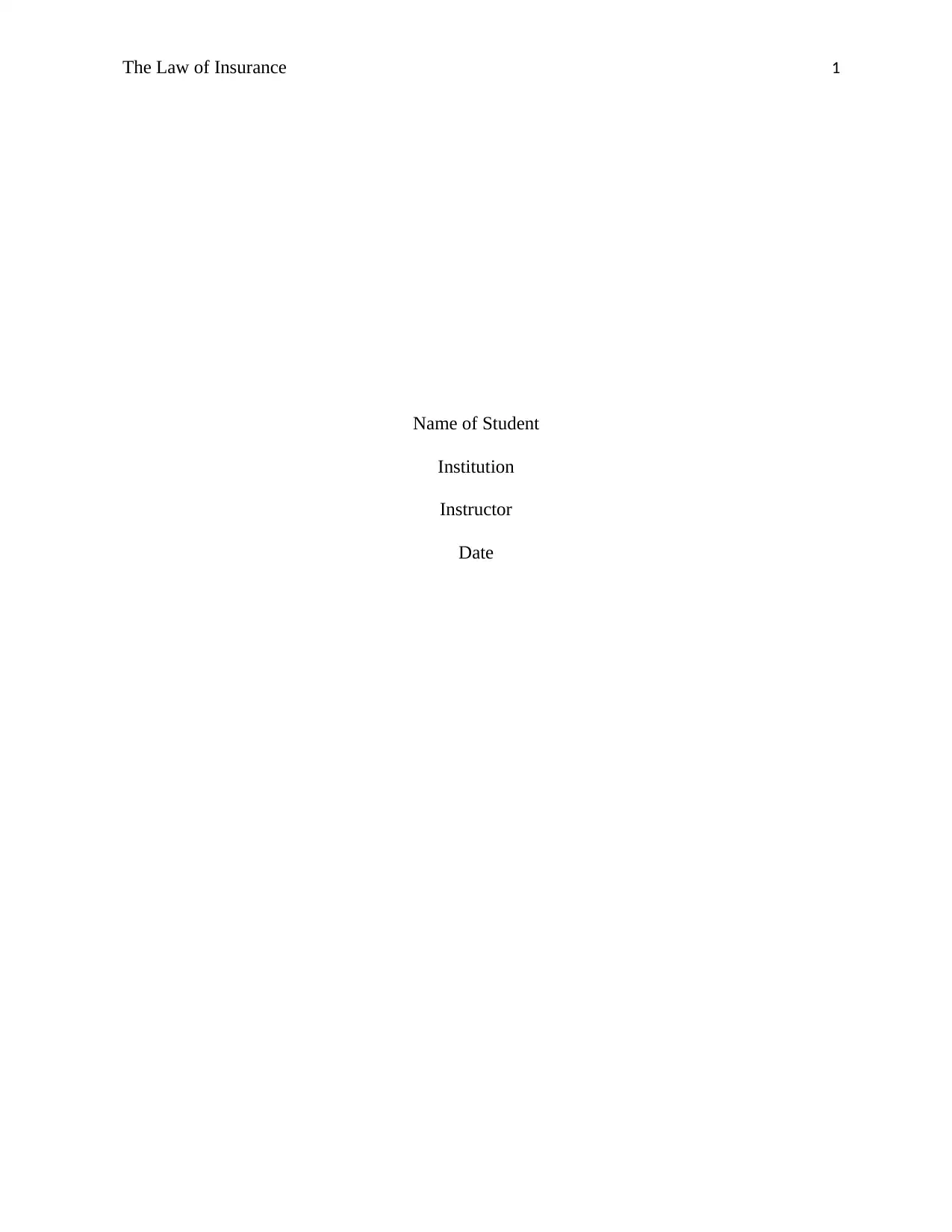
The Law of Insurance 1
Name of Student
Institution
Instructor
Date
Name of Student
Institution
Instructor
Date
Secure Best Marks with AI Grader
Need help grading? Try our AI Grader for instant feedback on your assignments.
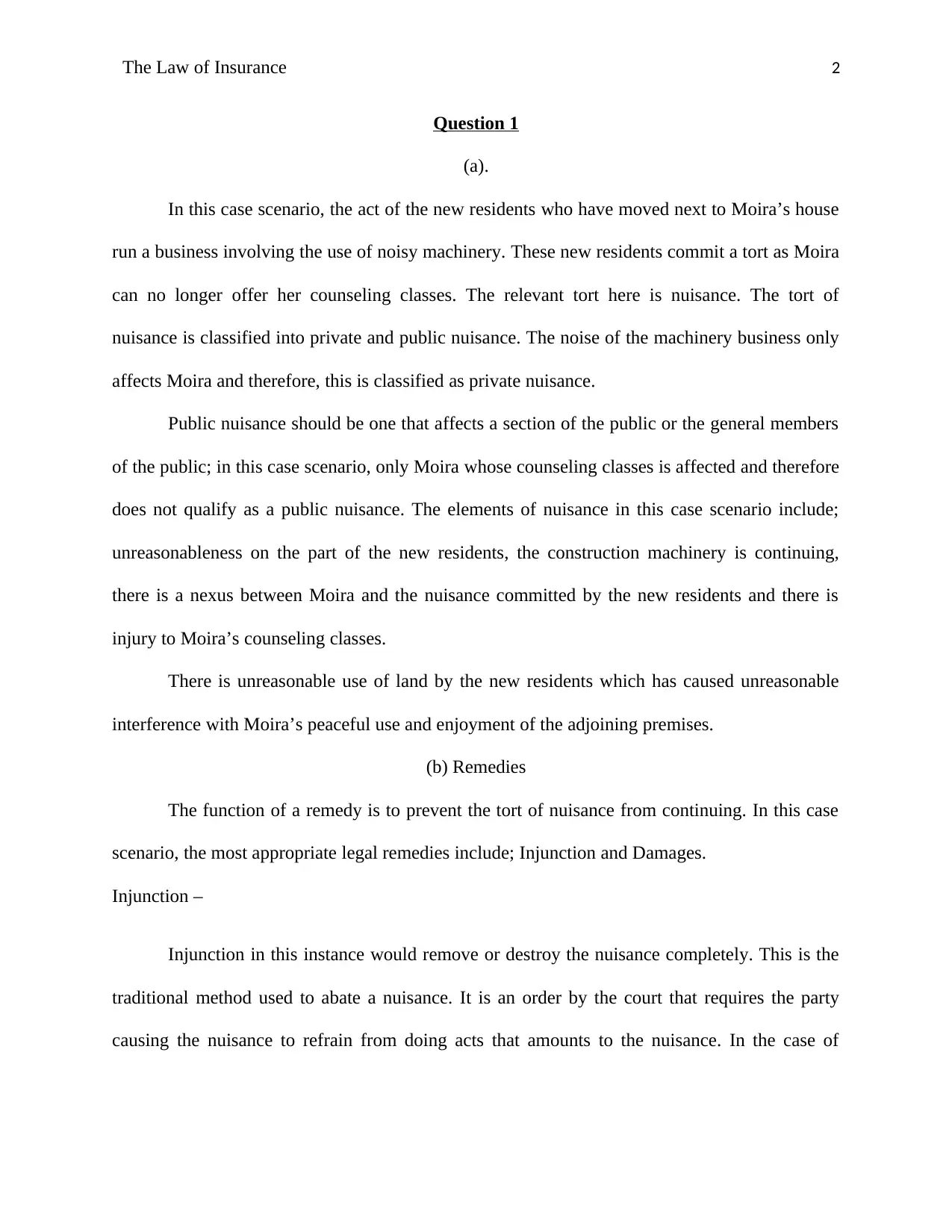
The Law of Insurance 2
Question 1
(a).
In this case scenario, the act of the new residents who have moved next to Moira’s house
run a business involving the use of noisy machinery. These new residents commit a tort as Moira
can no longer offer her counseling classes. The relevant tort here is nuisance. The tort of
nuisance is classified into private and public nuisance. The noise of the machinery business only
affects Moira and therefore, this is classified as private nuisance.
Public nuisance should be one that affects a section of the public or the general members
of the public; in this case scenario, only Moira whose counseling classes is affected and therefore
does not qualify as a public nuisance. The elements of nuisance in this case scenario include;
unreasonableness on the part of the new residents, the construction machinery is continuing,
there is a nexus between Moira and the nuisance committed by the new residents and there is
injury to Moira’s counseling classes.
There is unreasonable use of land by the new residents which has caused unreasonable
interference with Moira’s peaceful use and enjoyment of the adjoining premises.
(b) Remedies
The function of a remedy is to prevent the tort of nuisance from continuing. In this case
scenario, the most appropriate legal remedies include; Injunction and Damages.
Injunction –
Injunction in this instance would remove or destroy the nuisance completely. This is the
traditional method used to abate a nuisance. It is an order by the court that requires the party
causing the nuisance to refrain from doing acts that amounts to the nuisance. In the case of
Question 1
(a).
In this case scenario, the act of the new residents who have moved next to Moira’s house
run a business involving the use of noisy machinery. These new residents commit a tort as Moira
can no longer offer her counseling classes. The relevant tort here is nuisance. The tort of
nuisance is classified into private and public nuisance. The noise of the machinery business only
affects Moira and therefore, this is classified as private nuisance.
Public nuisance should be one that affects a section of the public or the general members
of the public; in this case scenario, only Moira whose counseling classes is affected and therefore
does not qualify as a public nuisance. The elements of nuisance in this case scenario include;
unreasonableness on the part of the new residents, the construction machinery is continuing,
there is a nexus between Moira and the nuisance committed by the new residents and there is
injury to Moira’s counseling classes.
There is unreasonable use of land by the new residents which has caused unreasonable
interference with Moira’s peaceful use and enjoyment of the adjoining premises.
(b) Remedies
The function of a remedy is to prevent the tort of nuisance from continuing. In this case
scenario, the most appropriate legal remedies include; Injunction and Damages.
Injunction –
Injunction in this instance would remove or destroy the nuisance completely. This is the
traditional method used to abate a nuisance. It is an order by the court that requires the party
causing the nuisance to refrain from doing acts that amounts to the nuisance. In the case of

The Law of Insurance 3
Kennaway v Thompson [1981] QB 88 Court of Appeal, the court granted an injunction to stop a
nuisance and stated that damages was not adequate in the circumstances.
Damages –
This is a compensatory form of payment in form of money for a wrong done to another
person. It is a discretionary remedy used where the threat or nuisance is not permanent but has
led to economic loss on the part of the claimant. In this case, Moira is likely to lose her
counseling students. In Pacific Engineering Ltd v Haji Ahmad Rice Mill Ltd, it was stated that a
person can bring an action and claim damages for injury or loss resulting from nuisance as well
as sue for injunction.
Question 2
(a)
Parties to a contract have rights and obligations under the contract. A contract is an
agreement between two or more parties intended to be legally binding and enforceable in a court
of law. There are essential elements required for a contract to be formed. They include; offer,
acceptance, intention, illegality, capacity and consideration. Rights and obligations only arise
after a valid contract has been formed.
In this case scenario, the issue is whether there was a valid contract giving Paul an
obligation to pay ABC plc his insurance premium at the time of contract formation. From the
terms of the contract, payment of premium was on a monthly basis. This means that the
consideration was a promise by Paul to pay premium in exchange for insurance cover. Payment
could be made at any time within the month. This gave rise to the obligation to make payment
within a reasonable time in the course of the month. He was therefore required to make a deposit
in his account so that premium can be deducted by ABC plc. According to LSW301, premium in
Kennaway v Thompson [1981] QB 88 Court of Appeal, the court granted an injunction to stop a
nuisance and stated that damages was not adequate in the circumstances.
Damages –
This is a compensatory form of payment in form of money for a wrong done to another
person. It is a discretionary remedy used where the threat or nuisance is not permanent but has
led to economic loss on the part of the claimant. In this case, Moira is likely to lose her
counseling students. In Pacific Engineering Ltd v Haji Ahmad Rice Mill Ltd, it was stated that a
person can bring an action and claim damages for injury or loss resulting from nuisance as well
as sue for injunction.
Question 2
(a)
Parties to a contract have rights and obligations under the contract. A contract is an
agreement between two or more parties intended to be legally binding and enforceable in a court
of law. There are essential elements required for a contract to be formed. They include; offer,
acceptance, intention, illegality, capacity and consideration. Rights and obligations only arise
after a valid contract has been formed.
In this case scenario, the issue is whether there was a valid contract giving Paul an
obligation to pay ABC plc his insurance premium at the time of contract formation. From the
terms of the contract, payment of premium was on a monthly basis. This means that the
consideration was a promise by Paul to pay premium in exchange for insurance cover. Payment
could be made at any time within the month. This gave rise to the obligation to make payment
within a reasonable time in the course of the month. He was therefore required to make a deposit
in his account so that premium can be deducted by ABC plc. According to LSW301, premium in
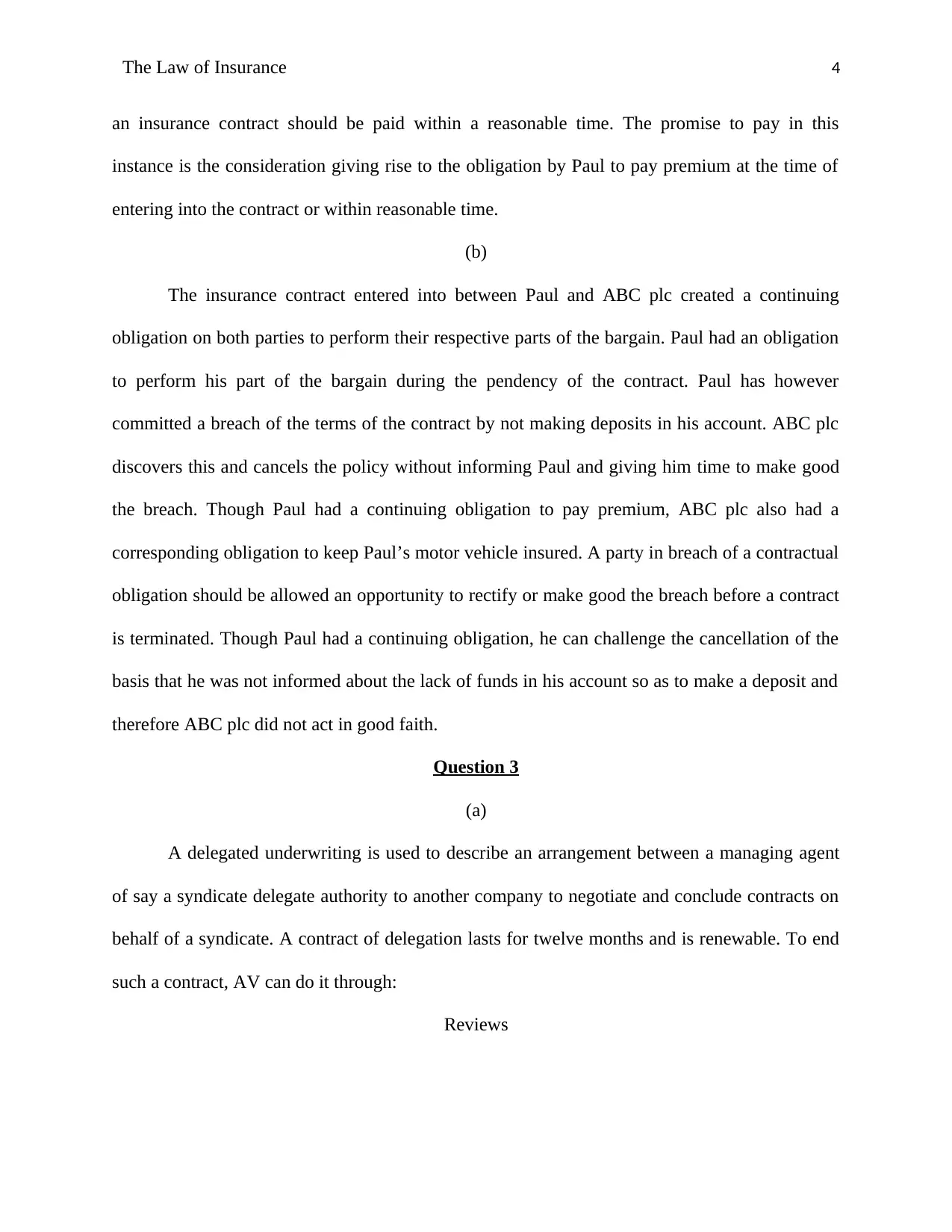
The Law of Insurance 4
an insurance contract should be paid within a reasonable time. The promise to pay in this
instance is the consideration giving rise to the obligation by Paul to pay premium at the time of
entering into the contract or within reasonable time.
(b)
The insurance contract entered into between Paul and ABC plc created a continuing
obligation on both parties to perform their respective parts of the bargain. Paul had an obligation
to perform his part of the bargain during the pendency of the contract. Paul has however
committed a breach of the terms of the contract by not making deposits in his account. ABC plc
discovers this and cancels the policy without informing Paul and giving him time to make good
the breach. Though Paul had a continuing obligation to pay premium, ABC plc also had a
corresponding obligation to keep Paul’s motor vehicle insured. A party in breach of a contractual
obligation should be allowed an opportunity to rectify or make good the breach before a contract
is terminated. Though Paul had a continuing obligation, he can challenge the cancellation of the
basis that he was not informed about the lack of funds in his account so as to make a deposit and
therefore ABC plc did not act in good faith.
Question 3
(a)
A delegated underwriting is used to describe an arrangement between a managing agent
of say a syndicate delegate authority to another company to negotiate and conclude contracts on
behalf of a syndicate. A contract of delegation lasts for twelve months and is renewable. To end
such a contract, AV can do it through:
Reviews
an insurance contract should be paid within a reasonable time. The promise to pay in this
instance is the consideration giving rise to the obligation by Paul to pay premium at the time of
entering into the contract or within reasonable time.
(b)
The insurance contract entered into between Paul and ABC plc created a continuing
obligation on both parties to perform their respective parts of the bargain. Paul had an obligation
to perform his part of the bargain during the pendency of the contract. Paul has however
committed a breach of the terms of the contract by not making deposits in his account. ABC plc
discovers this and cancels the policy without informing Paul and giving him time to make good
the breach. Though Paul had a continuing obligation to pay premium, ABC plc also had a
corresponding obligation to keep Paul’s motor vehicle insured. A party in breach of a contractual
obligation should be allowed an opportunity to rectify or make good the breach before a contract
is terminated. Though Paul had a continuing obligation, he can challenge the cancellation of the
basis that he was not informed about the lack of funds in his account so as to make a deposit and
therefore ABC plc did not act in good faith.
Question 3
(a)
A delegated underwriting is used to describe an arrangement between a managing agent
of say a syndicate delegate authority to another company to negotiate and conclude contracts on
behalf of a syndicate. A contract of delegation lasts for twelve months and is renewable. To end
such a contract, AV can do it through:
Reviews
Secure Best Marks with AI Grader
Need help grading? Try our AI Grader for instant feedback on your assignments.

The Law of Insurance 5
A contract of delegation is subject to review every twelve months. During the review, the
insurer has the discretion to terminate certain contracts of delegation that seems not to be
undertaking their mandate as required of them under the contract. During such review, the
insurer can decide to terminate all the contracts of delegation on the basis that such contracts
have failed to acquire or obtained their mandate under the contract.
Cancellation
A contract of delegation can be terminated through cancellation. This is done where there
are myriad problems with the performance of the contract such as failure to meet requirements
on regulation. In undertaking a cancellation, it is necessary that the relevant and required notices
are issued so as to comply with all the legal requirements. The notice of cancellation should be
one that takes effect within the time indicated in the notice.
Non-renewal
A delegated underwriting contract can be terminated through non-renewal. This can be
done for just cause such as failure to meet an underwriting target as well as changes in the offices
of the cover holder.
(b)
A managing director is the soul and mind of a company. He or she is the one involved in
policy making and the day to day operations of a company. The death of such a person makes a
company ineffective as it will not be able to make and take decisions as before.
The managing director is the one who implements and directs the operations of a company
towards the realization of its targets both long term and short term. The death therefore will
hinder the company from achieving its set objectives and strategies and in the long run, leads to
loss of business. The chain of communication is broken when a managing director dies. The
A contract of delegation is subject to review every twelve months. During the review, the
insurer has the discretion to terminate certain contracts of delegation that seems not to be
undertaking their mandate as required of them under the contract. During such review, the
insurer can decide to terminate all the contracts of delegation on the basis that such contracts
have failed to acquire or obtained their mandate under the contract.
Cancellation
A contract of delegation can be terminated through cancellation. This is done where there
are myriad problems with the performance of the contract such as failure to meet requirements
on regulation. In undertaking a cancellation, it is necessary that the relevant and required notices
are issued so as to comply with all the legal requirements. The notice of cancellation should be
one that takes effect within the time indicated in the notice.
Non-renewal
A delegated underwriting contract can be terminated through non-renewal. This can be
done for just cause such as failure to meet an underwriting target as well as changes in the offices
of the cover holder.
(b)
A managing director is the soul and mind of a company. He or she is the one involved in
policy making and the day to day operations of a company. The death of such a person makes a
company ineffective as it will not be able to make and take decisions as before.
The managing director is the one who implements and directs the operations of a company
towards the realization of its targets both long term and short term. The death therefore will
hinder the company from achieving its set objectives and strategies and in the long run, leads to
loss of business. The chain of communication is broken when a managing director dies. The
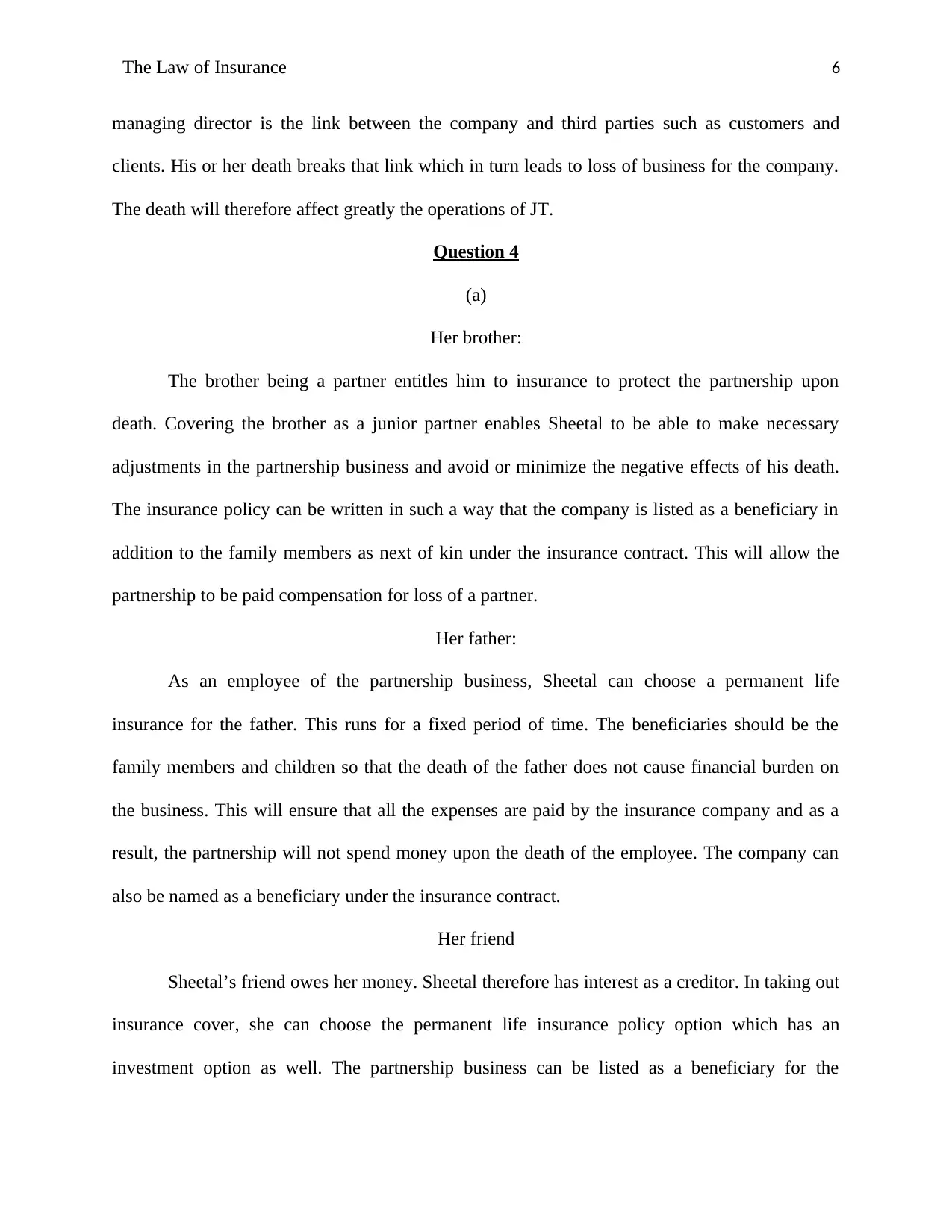
The Law of Insurance 6
managing director is the link between the company and third parties such as customers and
clients. His or her death breaks that link which in turn leads to loss of business for the company.
The death will therefore affect greatly the operations of JT.
Question 4
(a)
Her brother:
The brother being a partner entitles him to insurance to protect the partnership upon
death. Covering the brother as a junior partner enables Sheetal to be able to make necessary
adjustments in the partnership business and avoid or minimize the negative effects of his death.
The insurance policy can be written in such a way that the company is listed as a beneficiary in
addition to the family members as next of kin under the insurance contract. This will allow the
partnership to be paid compensation for loss of a partner.
Her father:
As an employee of the partnership business, Sheetal can choose a permanent life
insurance for the father. This runs for a fixed period of time. The beneficiaries should be the
family members and children so that the death of the father does not cause financial burden on
the business. This will ensure that all the expenses are paid by the insurance company and as a
result, the partnership will not spend money upon the death of the employee. The company can
also be named as a beneficiary under the insurance contract.
Her friend
Sheetal’s friend owes her money. Sheetal therefore has interest as a creditor. In taking out
insurance cover, she can choose the permanent life insurance policy option which has an
investment option as well. The partnership business can be listed as a beneficiary for the
managing director is the link between the company and third parties such as customers and
clients. His or her death breaks that link which in turn leads to loss of business for the company.
The death will therefore affect greatly the operations of JT.
Question 4
(a)
Her brother:
The brother being a partner entitles him to insurance to protect the partnership upon
death. Covering the brother as a junior partner enables Sheetal to be able to make necessary
adjustments in the partnership business and avoid or minimize the negative effects of his death.
The insurance policy can be written in such a way that the company is listed as a beneficiary in
addition to the family members as next of kin under the insurance contract. This will allow the
partnership to be paid compensation for loss of a partner.
Her father:
As an employee of the partnership business, Sheetal can choose a permanent life
insurance for the father. This runs for a fixed period of time. The beneficiaries should be the
family members and children so that the death of the father does not cause financial burden on
the business. This will ensure that all the expenses are paid by the insurance company and as a
result, the partnership will not spend money upon the death of the employee. The company can
also be named as a beneficiary under the insurance contract.
Her friend
Sheetal’s friend owes her money. Sheetal therefore has interest as a creditor. In taking out
insurance cover, she can choose the permanent life insurance policy option which has an
investment option as well. The partnership business can be listed as a beneficiary for the
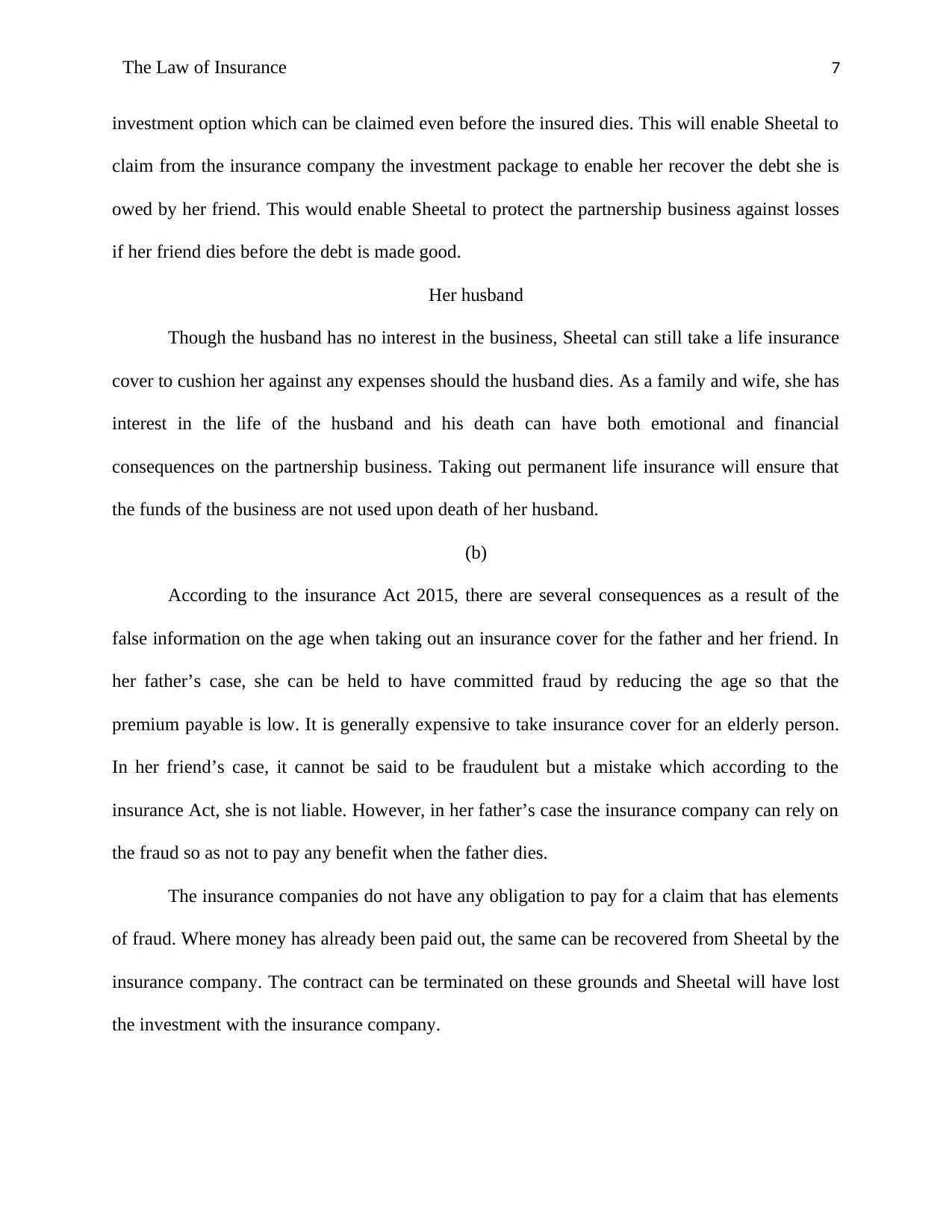
The Law of Insurance 7
investment option which can be claimed even before the insured dies. This will enable Sheetal to
claim from the insurance company the investment package to enable her recover the debt she is
owed by her friend. This would enable Sheetal to protect the partnership business against losses
if her friend dies before the debt is made good.
Her husband
Though the husband has no interest in the business, Sheetal can still take a life insurance
cover to cushion her against any expenses should the husband dies. As a family and wife, she has
interest in the life of the husband and his death can have both emotional and financial
consequences on the partnership business. Taking out permanent life insurance will ensure that
the funds of the business are not used upon death of her husband.
(b)
According to the insurance Act 2015, there are several consequences as a result of the
false information on the age when taking out an insurance cover for the father and her friend. In
her father’s case, she can be held to have committed fraud by reducing the age so that the
premium payable is low. It is generally expensive to take insurance cover for an elderly person.
In her friend’s case, it cannot be said to be fraudulent but a mistake which according to the
insurance Act, she is not liable. However, in her father’s case the insurance company can rely on
the fraud so as not to pay any benefit when the father dies.
The insurance companies do not have any obligation to pay for a claim that has elements
of fraud. Where money has already been paid out, the same can be recovered from Sheetal by the
insurance company. The contract can be terminated on these grounds and Sheetal will have lost
the investment with the insurance company.
investment option which can be claimed even before the insured dies. This will enable Sheetal to
claim from the insurance company the investment package to enable her recover the debt she is
owed by her friend. This would enable Sheetal to protect the partnership business against losses
if her friend dies before the debt is made good.
Her husband
Though the husband has no interest in the business, Sheetal can still take a life insurance
cover to cushion her against any expenses should the husband dies. As a family and wife, she has
interest in the life of the husband and his death can have both emotional and financial
consequences on the partnership business. Taking out permanent life insurance will ensure that
the funds of the business are not used upon death of her husband.
(b)
According to the insurance Act 2015, there are several consequences as a result of the
false information on the age when taking out an insurance cover for the father and her friend. In
her father’s case, she can be held to have committed fraud by reducing the age so that the
premium payable is low. It is generally expensive to take insurance cover for an elderly person.
In her friend’s case, it cannot be said to be fraudulent but a mistake which according to the
insurance Act, she is not liable. However, in her father’s case the insurance company can rely on
the fraud so as not to pay any benefit when the father dies.
The insurance companies do not have any obligation to pay for a claim that has elements
of fraud. Where money has already been paid out, the same can be recovered from Sheetal by the
insurance company. The contract can be terminated on these grounds and Sheetal will have lost
the investment with the insurance company.
Paraphrase This Document
Need a fresh take? Get an instant paraphrase of this document with our AI Paraphraser
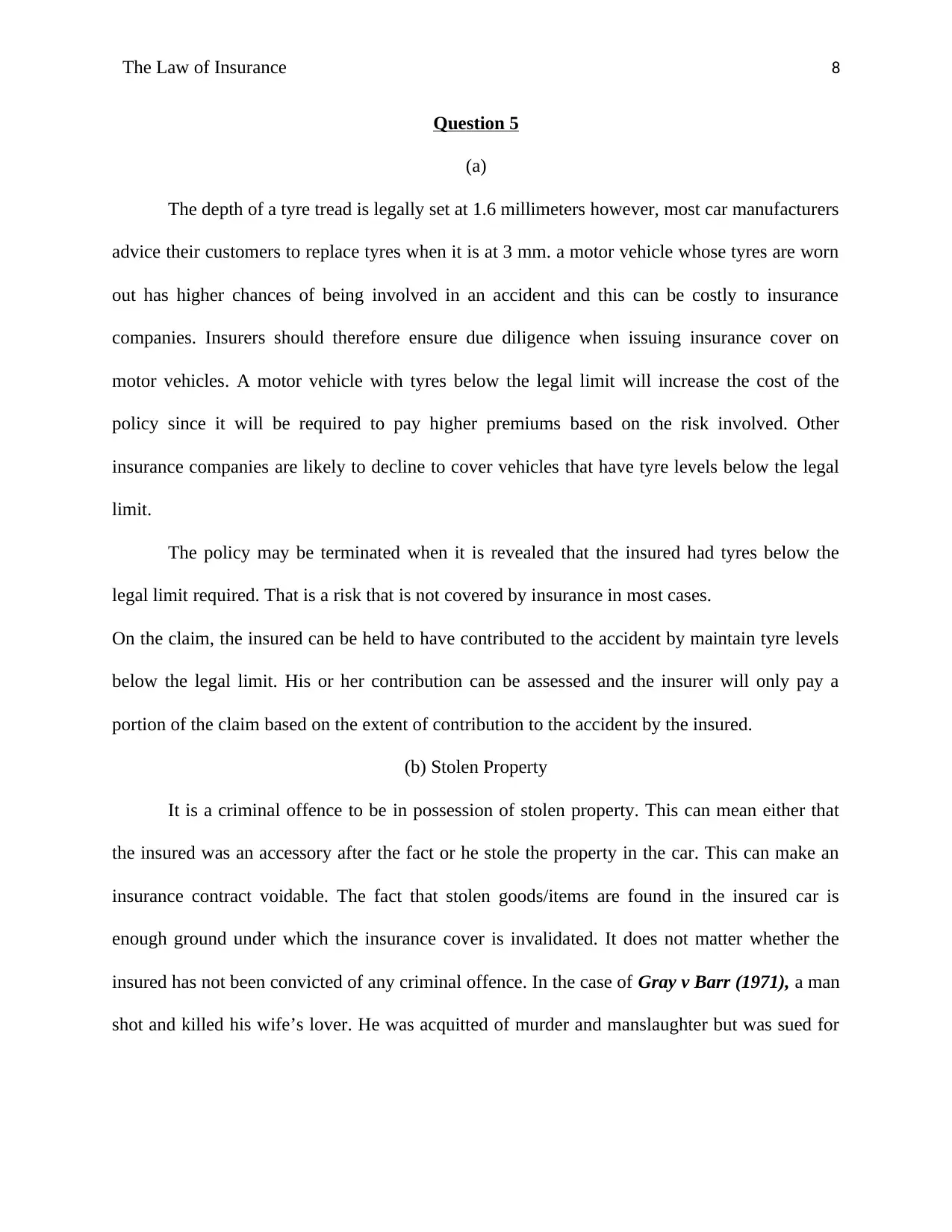
The Law of Insurance 8
Question 5
(a)
The depth of a tyre tread is legally set at 1.6 millimeters however, most car manufacturers
advice their customers to replace tyres when it is at 3 mm. a motor vehicle whose tyres are worn
out has higher chances of being involved in an accident and this can be costly to insurance
companies. Insurers should therefore ensure due diligence when issuing insurance cover on
motor vehicles. A motor vehicle with tyres below the legal limit will increase the cost of the
policy since it will be required to pay higher premiums based on the risk involved. Other
insurance companies are likely to decline to cover vehicles that have tyre levels below the legal
limit.
The policy may be terminated when it is revealed that the insured had tyres below the
legal limit required. That is a risk that is not covered by insurance in most cases.
On the claim, the insured can be held to have contributed to the accident by maintain tyre levels
below the legal limit. His or her contribution can be assessed and the insurer will only pay a
portion of the claim based on the extent of contribution to the accident by the insured.
(b) Stolen Property
It is a criminal offence to be in possession of stolen property. This can mean either that
the insured was an accessory after the fact or he stole the property in the car. This can make an
insurance contract voidable. The fact that stolen goods/items are found in the insured car is
enough ground under which the insurance cover is invalidated. It does not matter whether the
insured has not been convicted of any criminal offence. In the case of Gray v Barr (1971), a man
shot and killed his wife’s lover. He was acquitted of murder and manslaughter but was sued for
Question 5
(a)
The depth of a tyre tread is legally set at 1.6 millimeters however, most car manufacturers
advice their customers to replace tyres when it is at 3 mm. a motor vehicle whose tyres are worn
out has higher chances of being involved in an accident and this can be costly to insurance
companies. Insurers should therefore ensure due diligence when issuing insurance cover on
motor vehicles. A motor vehicle with tyres below the legal limit will increase the cost of the
policy since it will be required to pay higher premiums based on the risk involved. Other
insurance companies are likely to decline to cover vehicles that have tyre levels below the legal
limit.
The policy may be terminated when it is revealed that the insured had tyres below the
legal limit required. That is a risk that is not covered by insurance in most cases.
On the claim, the insured can be held to have contributed to the accident by maintain tyre levels
below the legal limit. His or her contribution can be assessed and the insurer will only pay a
portion of the claim based on the extent of contribution to the accident by the insured.
(b) Stolen Property
It is a criminal offence to be in possession of stolen property. This can mean either that
the insured was an accessory after the fact or he stole the property in the car. This can make an
insurance contract voidable. The fact that stolen goods/items are found in the insured car is
enough ground under which the insurance cover is invalidated. It does not matter whether the
insured has not been convicted of any criminal offence. In the case of Gray v Barr (1971), a man
shot and killed his wife’s lover. He was acquitted of murder and manslaughter but was sued for
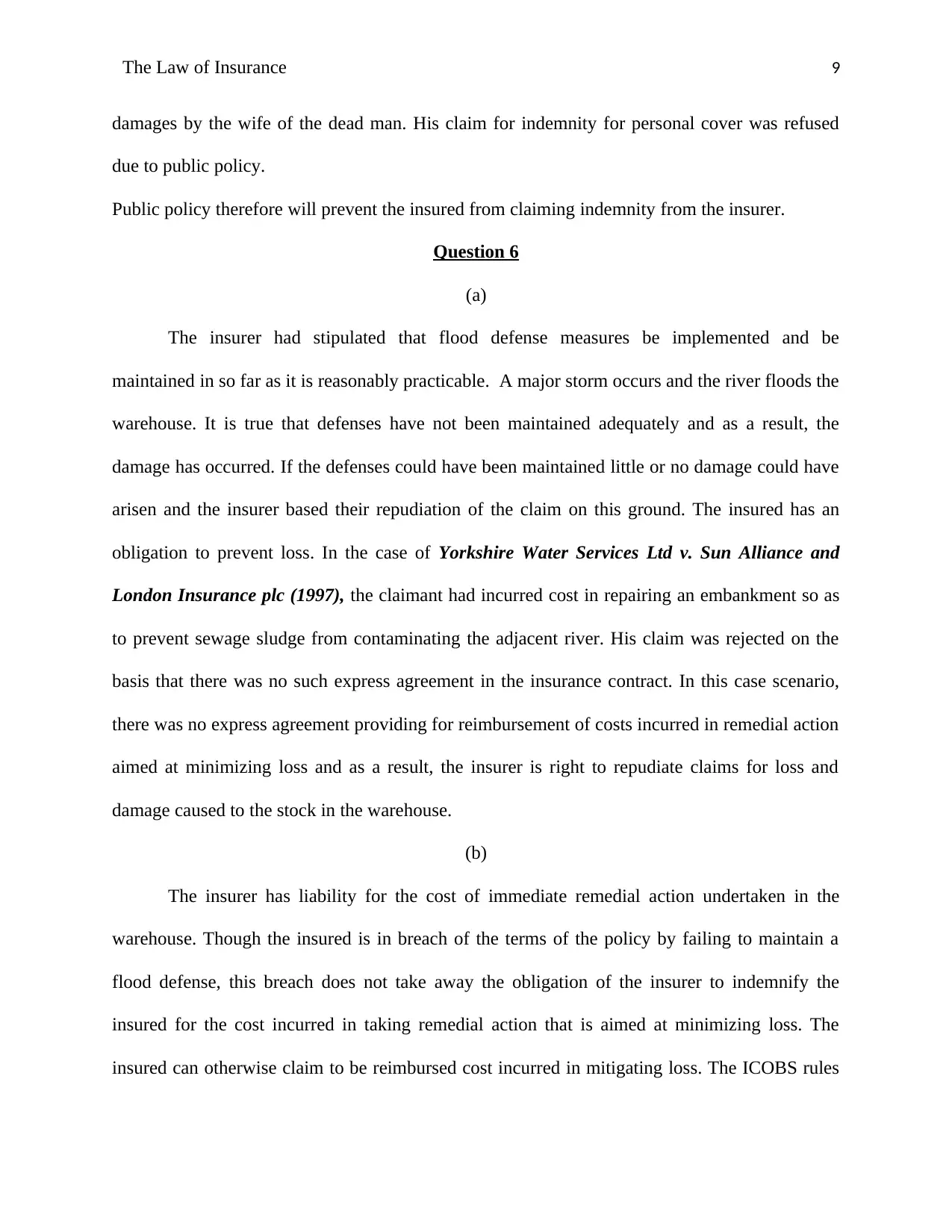
The Law of Insurance 9
damages by the wife of the dead man. His claim for indemnity for personal cover was refused
due to public policy.
Public policy therefore will prevent the insured from claiming indemnity from the insurer.
Question 6
(a)
The insurer had stipulated that flood defense measures be implemented and be
maintained in so far as it is reasonably practicable. A major storm occurs and the river floods the
warehouse. It is true that defenses have not been maintained adequately and as a result, the
damage has occurred. If the defenses could have been maintained little or no damage could have
arisen and the insurer based their repudiation of the claim on this ground. The insured has an
obligation to prevent loss. In the case of Yorkshire Water Services Ltd v. Sun Alliance and
London Insurance plc (1997), the claimant had incurred cost in repairing an embankment so as
to prevent sewage sludge from contaminating the adjacent river. His claim was rejected on the
basis that there was no such express agreement in the insurance contract. In this case scenario,
there was no express agreement providing for reimbursement of costs incurred in remedial action
aimed at minimizing loss and as a result, the insurer is right to repudiate claims for loss and
damage caused to the stock in the warehouse.
(b)
The insurer has liability for the cost of immediate remedial action undertaken in the
warehouse. Though the insured is in breach of the terms of the policy by failing to maintain a
flood defense, this breach does not take away the obligation of the insurer to indemnify the
insured for the cost incurred in taking remedial action that is aimed at minimizing loss. The
insured can otherwise claim to be reimbursed cost incurred in mitigating loss. The ICOBS rules
damages by the wife of the dead man. His claim for indemnity for personal cover was refused
due to public policy.
Public policy therefore will prevent the insured from claiming indemnity from the insurer.
Question 6
(a)
The insurer had stipulated that flood defense measures be implemented and be
maintained in so far as it is reasonably practicable. A major storm occurs and the river floods the
warehouse. It is true that defenses have not been maintained adequately and as a result, the
damage has occurred. If the defenses could have been maintained little or no damage could have
arisen and the insurer based their repudiation of the claim on this ground. The insured has an
obligation to prevent loss. In the case of Yorkshire Water Services Ltd v. Sun Alliance and
London Insurance plc (1997), the claimant had incurred cost in repairing an embankment so as
to prevent sewage sludge from contaminating the adjacent river. His claim was rejected on the
basis that there was no such express agreement in the insurance contract. In this case scenario,
there was no express agreement providing for reimbursement of costs incurred in remedial action
aimed at minimizing loss and as a result, the insurer is right to repudiate claims for loss and
damage caused to the stock in the warehouse.
(b)
The insurer has liability for the cost of immediate remedial action undertaken in the
warehouse. Though the insured is in breach of the terms of the policy by failing to maintain a
flood defense, this breach does not take away the obligation of the insurer to indemnify the
insured for the cost incurred in taking remedial action that is aimed at minimizing loss. The
insured can otherwise claim to be reimbursed cost incurred in mitigating loss. The ICOBS rules
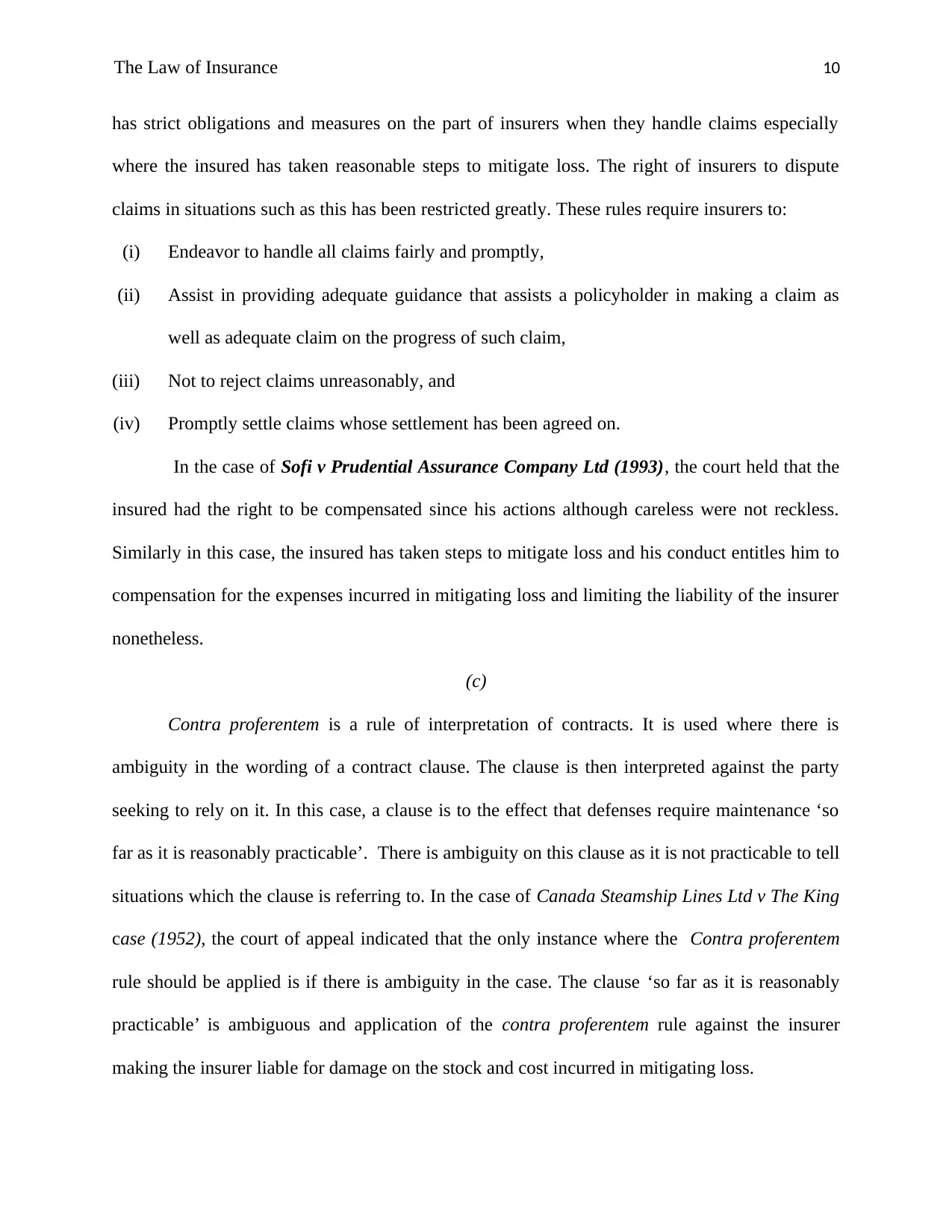
The Law of Insurance 10
has strict obligations and measures on the part of insurers when they handle claims especially
where the insured has taken reasonable steps to mitigate loss. The right of insurers to dispute
claims in situations such as this has been restricted greatly. These rules require insurers to:
(i) Endeavor to handle all claims fairly and promptly,
(ii) Assist in providing adequate guidance that assists a policyholder in making a claim as
well as adequate claim on the progress of such claim,
(iii) Not to reject claims unreasonably, and
(iv) Promptly settle claims whose settlement has been agreed on.
In the case of Sofi v Prudential Assurance Company Ltd (1993), the court held that the
insured had the right to be compensated since his actions although careless were not reckless.
Similarly in this case, the insured has taken steps to mitigate loss and his conduct entitles him to
compensation for the expenses incurred in mitigating loss and limiting the liability of the insurer
nonetheless.
(c)
Contra proferentem is a rule of interpretation of contracts. It is used where there is
ambiguity in the wording of a contract clause. The clause is then interpreted against the party
seeking to rely on it. In this case, a clause is to the effect that defenses require maintenance ‘so
far as it is reasonably practicable’. There is ambiguity on this clause as it is not practicable to tell
situations which the clause is referring to. In the case of Canada Steamship Lines Ltd v The King
case (1952), the court of appeal indicated that the only instance where the Contra proferentem
rule should be applied is if there is ambiguity in the case. The clause ‘so far as it is reasonably
practicable’ is ambiguous and application of the contra proferentem rule against the insurer
making the insurer liable for damage on the stock and cost incurred in mitigating loss.
has strict obligations and measures on the part of insurers when they handle claims especially
where the insured has taken reasonable steps to mitigate loss. The right of insurers to dispute
claims in situations such as this has been restricted greatly. These rules require insurers to:
(i) Endeavor to handle all claims fairly and promptly,
(ii) Assist in providing adequate guidance that assists a policyholder in making a claim as
well as adequate claim on the progress of such claim,
(iii) Not to reject claims unreasonably, and
(iv) Promptly settle claims whose settlement has been agreed on.
In the case of Sofi v Prudential Assurance Company Ltd (1993), the court held that the
insured had the right to be compensated since his actions although careless were not reckless.
Similarly in this case, the insured has taken steps to mitigate loss and his conduct entitles him to
compensation for the expenses incurred in mitigating loss and limiting the liability of the insurer
nonetheless.
(c)
Contra proferentem is a rule of interpretation of contracts. It is used where there is
ambiguity in the wording of a contract clause. The clause is then interpreted against the party
seeking to rely on it. In this case, a clause is to the effect that defenses require maintenance ‘so
far as it is reasonably practicable’. There is ambiguity on this clause as it is not practicable to tell
situations which the clause is referring to. In the case of Canada Steamship Lines Ltd v The King
case (1952), the court of appeal indicated that the only instance where the Contra proferentem
rule should be applied is if there is ambiguity in the case. The clause ‘so far as it is reasonably
practicable’ is ambiguous and application of the contra proferentem rule against the insurer
making the insurer liable for damage on the stock and cost incurred in mitigating loss.
Secure Best Marks with AI Grader
Need help grading? Try our AI Grader for instant feedback on your assignments.
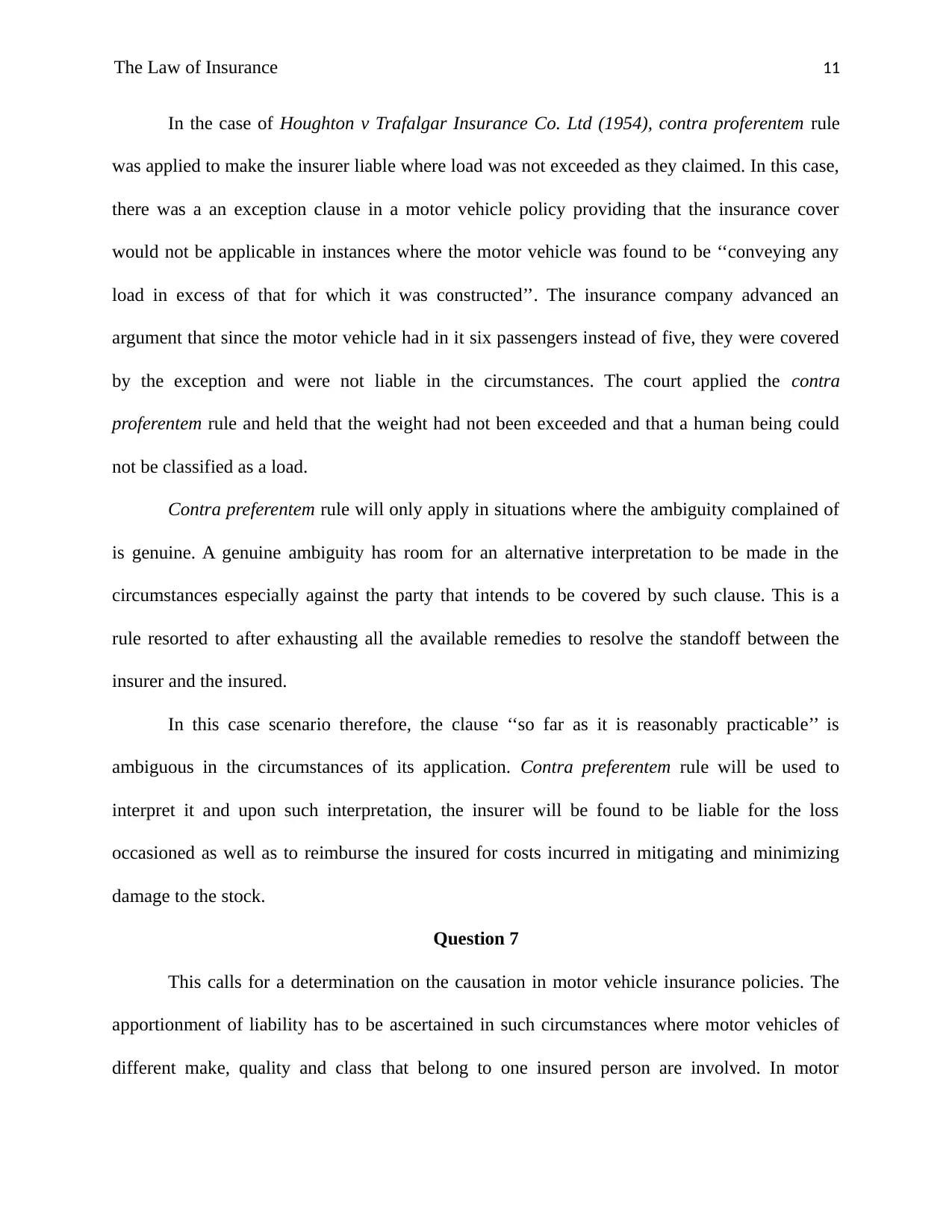
The Law of Insurance 11
In the case of Houghton v Trafalgar Insurance Co. Ltd (1954), contra proferentem rule
was applied to make the insurer liable where load was not exceeded as they claimed. In this case,
there was a an exception clause in a motor vehicle policy providing that the insurance cover
would not be applicable in instances where the motor vehicle was found to be ‘‘conveying any
load in excess of that for which it was constructed’’. The insurance company advanced an
argument that since the motor vehicle had in it six passengers instead of five, they were covered
by the exception and were not liable in the circumstances. The court applied the contra
proferentem rule and held that the weight had not been exceeded and that a human being could
not be classified as a load.
Contra preferentem rule will only apply in situations where the ambiguity complained of
is genuine. A genuine ambiguity has room for an alternative interpretation to be made in the
circumstances especially against the party that intends to be covered by such clause. This is a
rule resorted to after exhausting all the available remedies to resolve the standoff between the
insurer and the insured.
In this case scenario therefore, the clause ‘‘so far as it is reasonably practicable’’ is
ambiguous in the circumstances of its application. Contra preferentem rule will be used to
interpret it and upon such interpretation, the insurer will be found to be liable for the loss
occasioned as well as to reimburse the insured for costs incurred in mitigating and minimizing
damage to the stock.
Question 7
This calls for a determination on the causation in motor vehicle insurance policies. The
apportionment of liability has to be ascertained in such circumstances where motor vehicles of
different make, quality and class that belong to one insured person are involved. In motor
In the case of Houghton v Trafalgar Insurance Co. Ltd (1954), contra proferentem rule
was applied to make the insurer liable where load was not exceeded as they claimed. In this case,
there was a an exception clause in a motor vehicle policy providing that the insurance cover
would not be applicable in instances where the motor vehicle was found to be ‘‘conveying any
load in excess of that for which it was constructed’’. The insurance company advanced an
argument that since the motor vehicle had in it six passengers instead of five, they were covered
by the exception and were not liable in the circumstances. The court applied the contra
proferentem rule and held that the weight had not been exceeded and that a human being could
not be classified as a load.
Contra preferentem rule will only apply in situations where the ambiguity complained of
is genuine. A genuine ambiguity has room for an alternative interpretation to be made in the
circumstances especially against the party that intends to be covered by such clause. This is a
rule resorted to after exhausting all the available remedies to resolve the standoff between the
insurer and the insured.
In this case scenario therefore, the clause ‘‘so far as it is reasonably practicable’’ is
ambiguous in the circumstances of its application. Contra preferentem rule will be used to
interpret it and upon such interpretation, the insurer will be found to be liable for the loss
occasioned as well as to reimburse the insured for costs incurred in mitigating and minimizing
damage to the stock.
Question 7
This calls for a determination on the causation in motor vehicle insurance policies. The
apportionment of liability has to be ascertained in such circumstances where motor vehicles of
different make, quality and class that belong to one insured person are involved. In motor
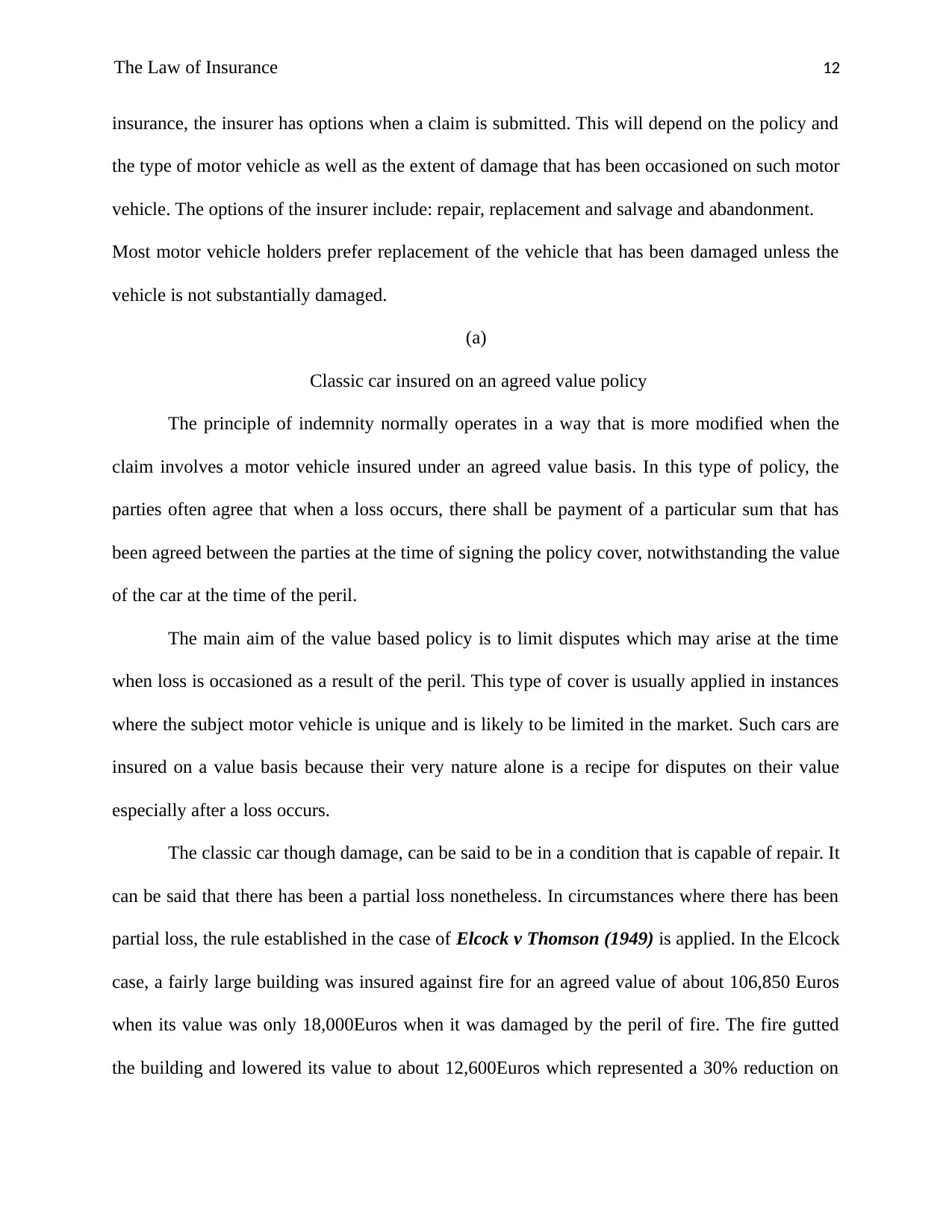
The Law of Insurance 12
insurance, the insurer has options when a claim is submitted. This will depend on the policy and
the type of motor vehicle as well as the extent of damage that has been occasioned on such motor
vehicle. The options of the insurer include: repair, replacement and salvage and abandonment.
Most motor vehicle holders prefer replacement of the vehicle that has been damaged unless the
vehicle is not substantially damaged.
(a)
Classic car insured on an agreed value policy
The principle of indemnity normally operates in a way that is more modified when the
claim involves a motor vehicle insured under an agreed value basis. In this type of policy, the
parties often agree that when a loss occurs, there shall be payment of a particular sum that has
been agreed between the parties at the time of signing the policy cover, notwithstanding the value
of the car at the time of the peril.
The main aim of the value based policy is to limit disputes which may arise at the time
when loss is occasioned as a result of the peril. This type of cover is usually applied in instances
where the subject motor vehicle is unique and is likely to be limited in the market. Such cars are
insured on a value basis because their very nature alone is a recipe for disputes on their value
especially after a loss occurs.
The classic car though damage, can be said to be in a condition that is capable of repair. It
can be said that there has been a partial loss nonetheless. In circumstances where there has been
partial loss, the rule established in the case of Elcock v Thomson (1949) is applied. In the Elcock
case, a fairly large building was insured against fire for an agreed value of about 106,850 Euros
when its value was only 18,000Euros when it was damaged by the peril of fire. The fire gutted
the building and lowered its value to about 12,600Euros which represented a 30% reduction on
insurance, the insurer has options when a claim is submitted. This will depend on the policy and
the type of motor vehicle as well as the extent of damage that has been occasioned on such motor
vehicle. The options of the insurer include: repair, replacement and salvage and abandonment.
Most motor vehicle holders prefer replacement of the vehicle that has been damaged unless the
vehicle is not substantially damaged.
(a)
Classic car insured on an agreed value policy
The principle of indemnity normally operates in a way that is more modified when the
claim involves a motor vehicle insured under an agreed value basis. In this type of policy, the
parties often agree that when a loss occurs, there shall be payment of a particular sum that has
been agreed between the parties at the time of signing the policy cover, notwithstanding the value
of the car at the time of the peril.
The main aim of the value based policy is to limit disputes which may arise at the time
when loss is occasioned as a result of the peril. This type of cover is usually applied in instances
where the subject motor vehicle is unique and is likely to be limited in the market. Such cars are
insured on a value basis because their very nature alone is a recipe for disputes on their value
especially after a loss occurs.
The classic car though damage, can be said to be in a condition that is capable of repair. It
can be said that there has been a partial loss nonetheless. In circumstances where there has been
partial loss, the rule established in the case of Elcock v Thomson (1949) is applied. In the Elcock
case, a fairly large building was insured against fire for an agreed value of about 106,850 Euros
when its value was only 18,000Euros when it was damaged by the peril of fire. The fire gutted
the building and lowered its value to about 12,600Euros which represented a 30% reduction on
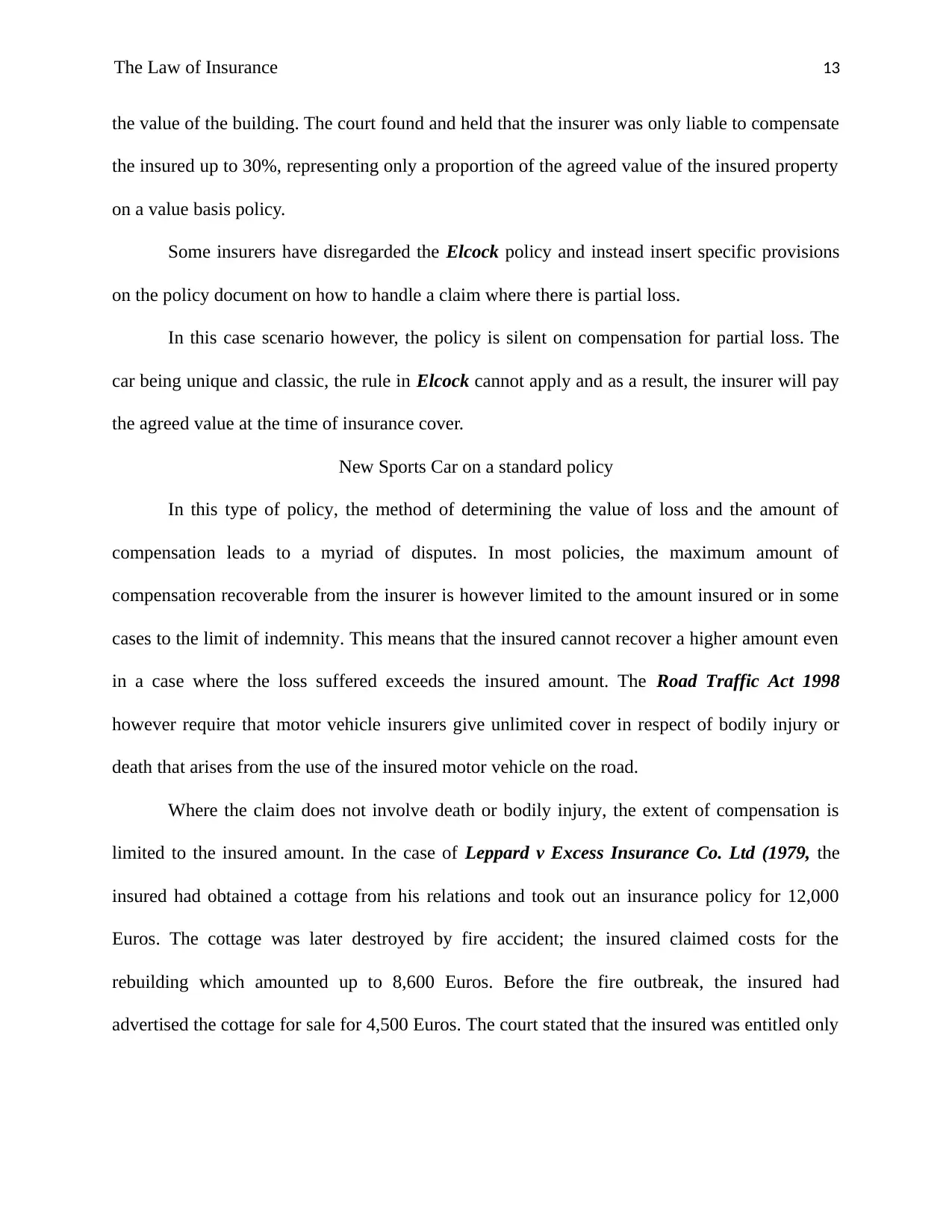
The Law of Insurance 13
the value of the building. The court found and held that the insurer was only liable to compensate
the insured up to 30%, representing only a proportion of the agreed value of the insured property
on a value basis policy.
Some insurers have disregarded the Elcock policy and instead insert specific provisions
on the policy document on how to handle a claim where there is partial loss.
In this case scenario however, the policy is silent on compensation for partial loss. The
car being unique and classic, the rule in Elcock cannot apply and as a result, the insurer will pay
the agreed value at the time of insurance cover.
New Sports Car on a standard policy
In this type of policy, the method of determining the value of loss and the amount of
compensation leads to a myriad of disputes. In most policies, the maximum amount of
compensation recoverable from the insurer is however limited to the amount insured or in some
cases to the limit of indemnity. This means that the insured cannot recover a higher amount even
in a case where the loss suffered exceeds the insured amount. The Road Traffic Act 1998
however require that motor vehicle insurers give unlimited cover in respect of bodily injury or
death that arises from the use of the insured motor vehicle on the road.
Where the claim does not involve death or bodily injury, the extent of compensation is
limited to the insured amount. In the case of Leppard v Excess Insurance Co. Ltd (1979, the
insured had obtained a cottage from his relations and took out an insurance policy for 12,000
Euros. The cottage was later destroyed by fire accident; the insured claimed costs for the
rebuilding which amounted up to 8,600 Euros. Before the fire outbreak, the insured had
advertised the cottage for sale for 4,500 Euros. The court stated that the insured was entitled only
the value of the building. The court found and held that the insurer was only liable to compensate
the insured up to 30%, representing only a proportion of the agreed value of the insured property
on a value basis policy.
Some insurers have disregarded the Elcock policy and instead insert specific provisions
on the policy document on how to handle a claim where there is partial loss.
In this case scenario however, the policy is silent on compensation for partial loss. The
car being unique and classic, the rule in Elcock cannot apply and as a result, the insurer will pay
the agreed value at the time of insurance cover.
New Sports Car on a standard policy
In this type of policy, the method of determining the value of loss and the amount of
compensation leads to a myriad of disputes. In most policies, the maximum amount of
compensation recoverable from the insurer is however limited to the amount insured or in some
cases to the limit of indemnity. This means that the insured cannot recover a higher amount even
in a case where the loss suffered exceeds the insured amount. The Road Traffic Act 1998
however require that motor vehicle insurers give unlimited cover in respect of bodily injury or
death that arises from the use of the insured motor vehicle on the road.
Where the claim does not involve death or bodily injury, the extent of compensation is
limited to the insured amount. In the case of Leppard v Excess Insurance Co. Ltd (1979, the
insured had obtained a cottage from his relations and took out an insurance policy for 12,000
Euros. The cottage was later destroyed by fire accident; the insured claimed costs for the
rebuilding which amounted up to 8,600 Euros. Before the fire outbreak, the insured had
advertised the cottage for sale for 4,500 Euros. The court stated that the insured was entitled only
Paraphrase This Document
Need a fresh take? Get an instant paraphrase of this document with our AI Paraphraser
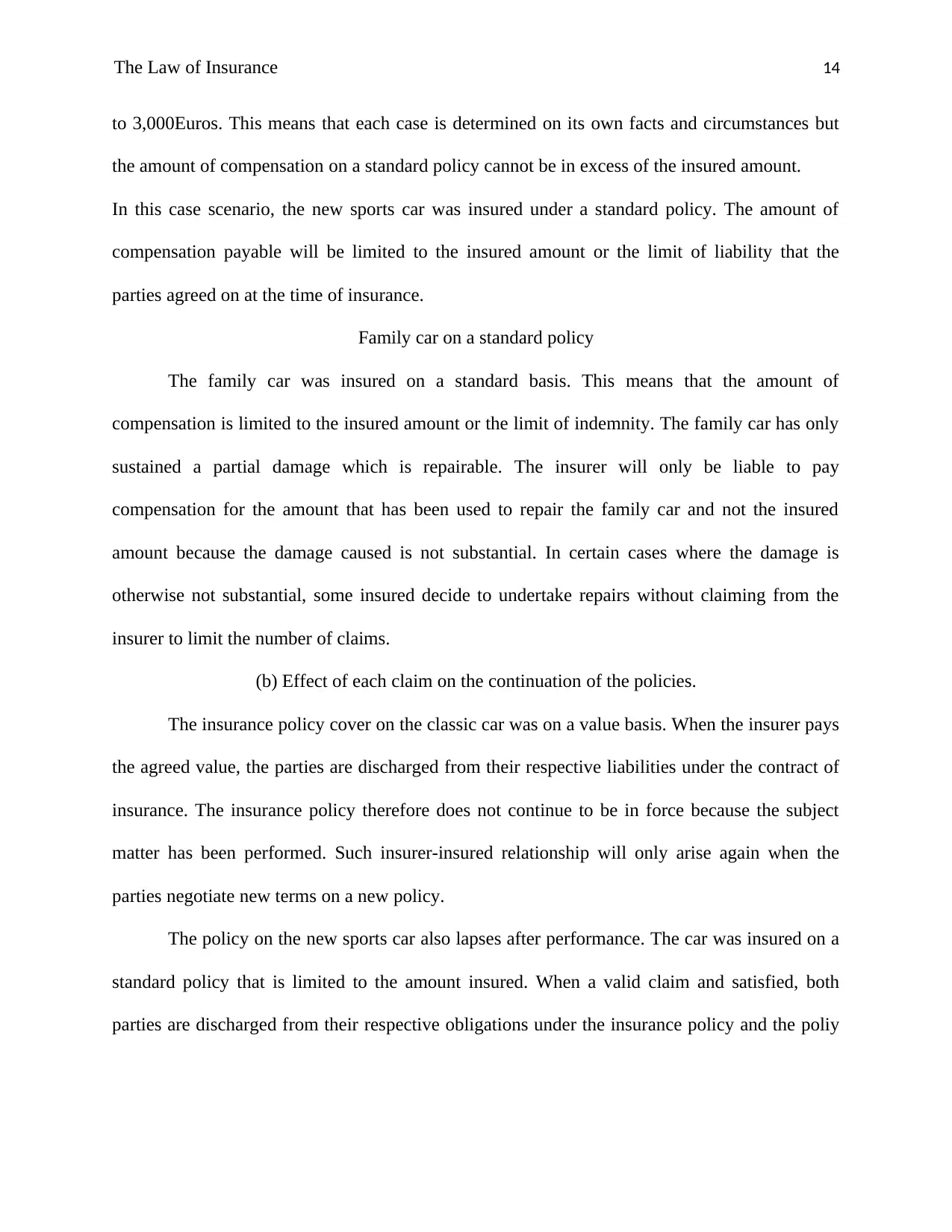
The Law of Insurance 14
to 3,000Euros. This means that each case is determined on its own facts and circumstances but
the amount of compensation on a standard policy cannot be in excess of the insured amount.
In this case scenario, the new sports car was insured under a standard policy. The amount of
compensation payable will be limited to the insured amount or the limit of liability that the
parties agreed on at the time of insurance.
Family car on a standard policy
The family car was insured on a standard basis. This means that the amount of
compensation is limited to the insured amount or the limit of indemnity. The family car has only
sustained a partial damage which is repairable. The insurer will only be liable to pay
compensation for the amount that has been used to repair the family car and not the insured
amount because the damage caused is not substantial. In certain cases where the damage is
otherwise not substantial, some insured decide to undertake repairs without claiming from the
insurer to limit the number of claims.
(b) Effect of each claim on the continuation of the policies.
The insurance policy cover on the classic car was on a value basis. When the insurer pays
the agreed value, the parties are discharged from their respective liabilities under the contract of
insurance. The insurance policy therefore does not continue to be in force because the subject
matter has been performed. Such insurer-insured relationship will only arise again when the
parties negotiate new terms on a new policy.
The policy on the new sports car also lapses after performance. The car was insured on a
standard policy that is limited to the amount insured. When a valid claim and satisfied, both
parties are discharged from their respective obligations under the insurance policy and the poliy
to 3,000Euros. This means that each case is determined on its own facts and circumstances but
the amount of compensation on a standard policy cannot be in excess of the insured amount.
In this case scenario, the new sports car was insured under a standard policy. The amount of
compensation payable will be limited to the insured amount or the limit of liability that the
parties agreed on at the time of insurance.
Family car on a standard policy
The family car was insured on a standard basis. This means that the amount of
compensation is limited to the insured amount or the limit of indemnity. The family car has only
sustained a partial damage which is repairable. The insurer will only be liable to pay
compensation for the amount that has been used to repair the family car and not the insured
amount because the damage caused is not substantial. In certain cases where the damage is
otherwise not substantial, some insured decide to undertake repairs without claiming from the
insurer to limit the number of claims.
(b) Effect of each claim on the continuation of the policies.
The insurance policy cover on the classic car was on a value basis. When the insurer pays
the agreed value, the parties are discharged from their respective liabilities under the contract of
insurance. The insurance policy therefore does not continue to be in force because the subject
matter has been performed. Such insurer-insured relationship will only arise again when the
parties negotiate new terms on a new policy.
The policy on the new sports car also lapses after performance. The car was insured on a
standard policy that is limited to the amount insured. When a valid claim and satisfied, both
parties are discharged from their respective obligations under the insurance policy and the poliy
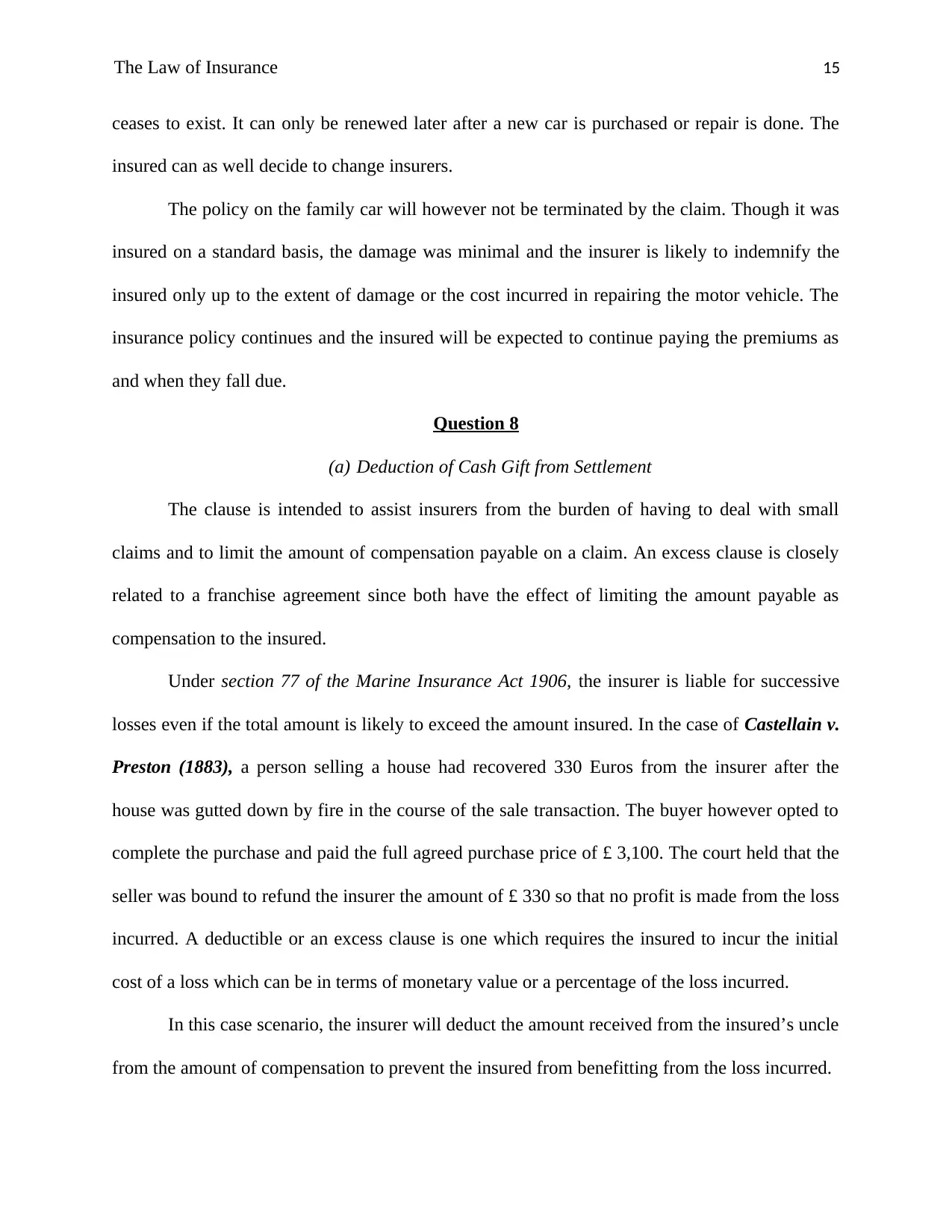
The Law of Insurance 15
ceases to exist. It can only be renewed later after a new car is purchased or repair is done. The
insured can as well decide to change insurers.
The policy on the family car will however not be terminated by the claim. Though it was
insured on a standard basis, the damage was minimal and the insurer is likely to indemnify the
insured only up to the extent of damage or the cost incurred in repairing the motor vehicle. The
insurance policy continues and the insured will be expected to continue paying the premiums as
and when they fall due.
Question 8
(a) Deduction of Cash Gift from Settlement
The clause is intended to assist insurers from the burden of having to deal with small
claims and to limit the amount of compensation payable on a claim. An excess clause is closely
related to a franchise agreement since both have the effect of limiting the amount payable as
compensation to the insured.
Under section 77 of the Marine Insurance Act 1906, the insurer is liable for successive
losses even if the total amount is likely to exceed the amount insured. In the case of Castellain v.
Preston (1883), a person selling a house had recovered 330 Euros from the insurer after the
house was gutted down by fire in the course of the sale transaction. The buyer however opted to
complete the purchase and paid the full agreed purchase price of £ 3,100. The court held that the
seller was bound to refund the insurer the amount of £ 330 so that no profit is made from the loss
incurred. A deductible or an excess clause is one which requires the insured to incur the initial
cost of a loss which can be in terms of monetary value or a percentage of the loss incurred.
In this case scenario, the insurer will deduct the amount received from the insured’s uncle
from the amount of compensation to prevent the insured from benefitting from the loss incurred.
ceases to exist. It can only be renewed later after a new car is purchased or repair is done. The
insured can as well decide to change insurers.
The policy on the family car will however not be terminated by the claim. Though it was
insured on a standard basis, the damage was minimal and the insurer is likely to indemnify the
insured only up to the extent of damage or the cost incurred in repairing the motor vehicle. The
insurance policy continues and the insured will be expected to continue paying the premiums as
and when they fall due.
Question 8
(a) Deduction of Cash Gift from Settlement
The clause is intended to assist insurers from the burden of having to deal with small
claims and to limit the amount of compensation payable on a claim. An excess clause is closely
related to a franchise agreement since both have the effect of limiting the amount payable as
compensation to the insured.
Under section 77 of the Marine Insurance Act 1906, the insurer is liable for successive
losses even if the total amount is likely to exceed the amount insured. In the case of Castellain v.
Preston (1883), a person selling a house had recovered 330 Euros from the insurer after the
house was gutted down by fire in the course of the sale transaction. The buyer however opted to
complete the purchase and paid the full agreed purchase price of £ 3,100. The court held that the
seller was bound to refund the insurer the amount of £ 330 so that no profit is made from the loss
incurred. A deductible or an excess clause is one which requires the insured to incur the initial
cost of a loss which can be in terms of monetary value or a percentage of the loss incurred.
In this case scenario, the insurer will deduct the amount received from the insured’s uncle
from the amount of compensation to prevent the insured from benefitting from the loss incurred.
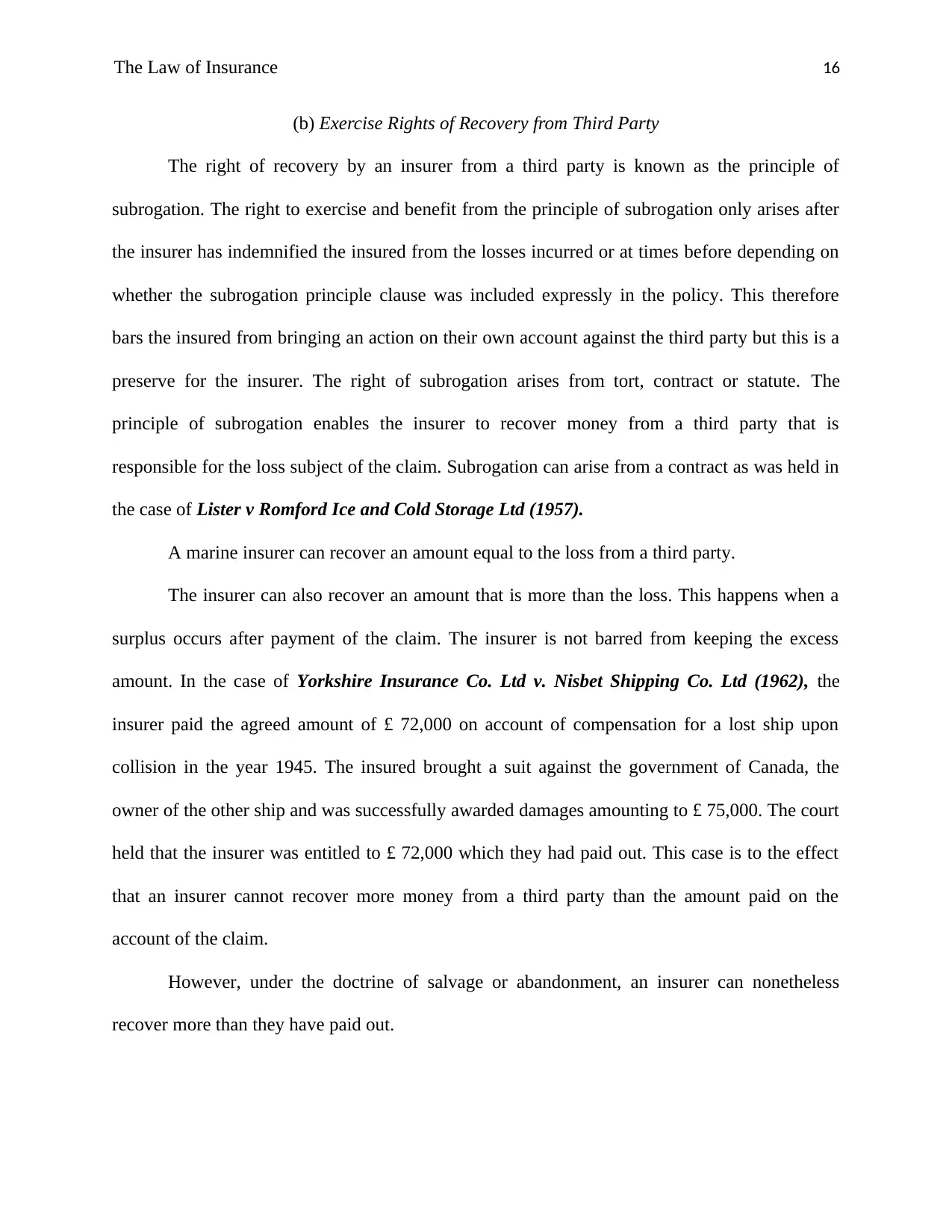
The Law of Insurance 16
(b) Exercise Rights of Recovery from Third Party
The right of recovery by an insurer from a third party is known as the principle of
subrogation. The right to exercise and benefit from the principle of subrogation only arises after
the insurer has indemnified the insured from the losses incurred or at times before depending on
whether the subrogation principle clause was included expressly in the policy. This therefore
bars the insured from bringing an action on their own account against the third party but this is a
preserve for the insurer. The right of subrogation arises from tort, contract or statute. The
principle of subrogation enables the insurer to recover money from a third party that is
responsible for the loss subject of the claim. Subrogation can arise from a contract as was held in
the case of Lister v Romford Ice and Cold Storage Ltd (1957).
A marine insurer can recover an amount equal to the loss from a third party.
The insurer can also recover an amount that is more than the loss. This happens when a
surplus occurs after payment of the claim. The insurer is not barred from keeping the excess
amount. In the case of Yorkshire Insurance Co. Ltd v. Nisbet Shipping Co. Ltd (1962), the
insurer paid the agreed amount of £ 72,000 on account of compensation for a lost ship upon
collision in the year 1945. The insured brought a suit against the government of Canada, the
owner of the other ship and was successfully awarded damages amounting to £ 75,000. The court
held that the insurer was entitled to £ 72,000 which they had paid out. This case is to the effect
that an insurer cannot recover more money from a third party than the amount paid on the
account of the claim.
However, under the doctrine of salvage or abandonment, an insurer can nonetheless
recover more than they have paid out.
(b) Exercise Rights of Recovery from Third Party
The right of recovery by an insurer from a third party is known as the principle of
subrogation. The right to exercise and benefit from the principle of subrogation only arises after
the insurer has indemnified the insured from the losses incurred or at times before depending on
whether the subrogation principle clause was included expressly in the policy. This therefore
bars the insured from bringing an action on their own account against the third party but this is a
preserve for the insurer. The right of subrogation arises from tort, contract or statute. The
principle of subrogation enables the insurer to recover money from a third party that is
responsible for the loss subject of the claim. Subrogation can arise from a contract as was held in
the case of Lister v Romford Ice and Cold Storage Ltd (1957).
A marine insurer can recover an amount equal to the loss from a third party.
The insurer can also recover an amount that is more than the loss. This happens when a
surplus occurs after payment of the claim. The insurer is not barred from keeping the excess
amount. In the case of Yorkshire Insurance Co. Ltd v. Nisbet Shipping Co. Ltd (1962), the
insurer paid the agreed amount of £ 72,000 on account of compensation for a lost ship upon
collision in the year 1945. The insured brought a suit against the government of Canada, the
owner of the other ship and was successfully awarded damages amounting to £ 75,000. The court
held that the insurer was entitled to £ 72,000 which they had paid out. This case is to the effect
that an insurer cannot recover more money from a third party than the amount paid on the
account of the claim.
However, under the doctrine of salvage or abandonment, an insurer can nonetheless
recover more than they have paid out.
Secure Best Marks with AI Grader
Need help grading? Try our AI Grader for instant feedback on your assignments.
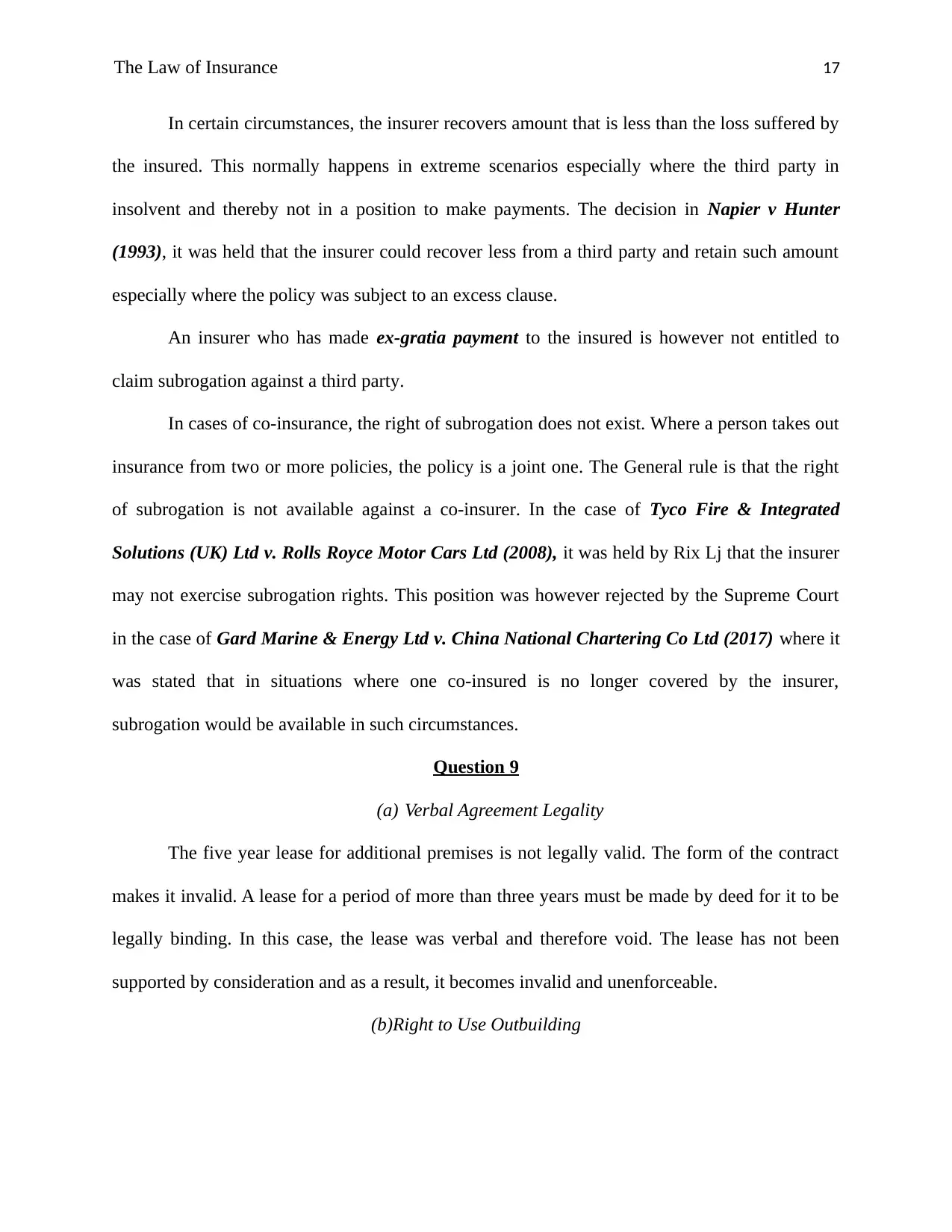
The Law of Insurance 17
In certain circumstances, the insurer recovers amount that is less than the loss suffered by
the insured. This normally happens in extreme scenarios especially where the third party in
insolvent and thereby not in a position to make payments. The decision in Napier v Hunter
(1993), it was held that the insurer could recover less from a third party and retain such amount
especially where the policy was subject to an excess clause.
An insurer who has made ex-gratia payment to the insured is however not entitled to
claim subrogation against a third party.
In cases of co-insurance, the right of subrogation does not exist. Where a person takes out
insurance from two or more policies, the policy is a joint one. The General rule is that the right
of subrogation is not available against a co-insurer. In the case of Tyco Fire & Integrated
Solutions (UK) Ltd v. Rolls Royce Motor Cars Ltd (2008), it was held by Rix Lj that the insurer
may not exercise subrogation rights. This position was however rejected by the Supreme Court
in the case of Gard Marine & Energy Ltd v. China National Chartering Co Ltd (2017) where it
was stated that in situations where one co-insured is no longer covered by the insurer,
subrogation would be available in such circumstances.
Question 9
(a) Verbal Agreement Legality
The five year lease for additional premises is not legally valid. The form of the contract
makes it invalid. A lease for a period of more than three years must be made by deed for it to be
legally binding. In this case, the lease was verbal and therefore void. The lease has not been
supported by consideration and as a result, it becomes invalid and unenforceable.
(b)Right to Use Outbuilding
In certain circumstances, the insurer recovers amount that is less than the loss suffered by
the insured. This normally happens in extreme scenarios especially where the third party in
insolvent and thereby not in a position to make payments. The decision in Napier v Hunter
(1993), it was held that the insurer could recover less from a third party and retain such amount
especially where the policy was subject to an excess clause.
An insurer who has made ex-gratia payment to the insured is however not entitled to
claim subrogation against a third party.
In cases of co-insurance, the right of subrogation does not exist. Where a person takes out
insurance from two or more policies, the policy is a joint one. The General rule is that the right
of subrogation is not available against a co-insurer. In the case of Tyco Fire & Integrated
Solutions (UK) Ltd v. Rolls Royce Motor Cars Ltd (2008), it was held by Rix Lj that the insurer
may not exercise subrogation rights. This position was however rejected by the Supreme Court
in the case of Gard Marine & Energy Ltd v. China National Chartering Co Ltd (2017) where it
was stated that in situations where one co-insured is no longer covered by the insurer,
subrogation would be available in such circumstances.
Question 9
(a) Verbal Agreement Legality
The five year lease for additional premises is not legally valid. The form of the contract
makes it invalid. A lease for a period of more than three years must be made by deed for it to be
legally binding. In this case, the lease was verbal and therefore void. The lease has not been
supported by consideration and as a result, it becomes invalid and unenforceable.
(b)Right to Use Outbuilding
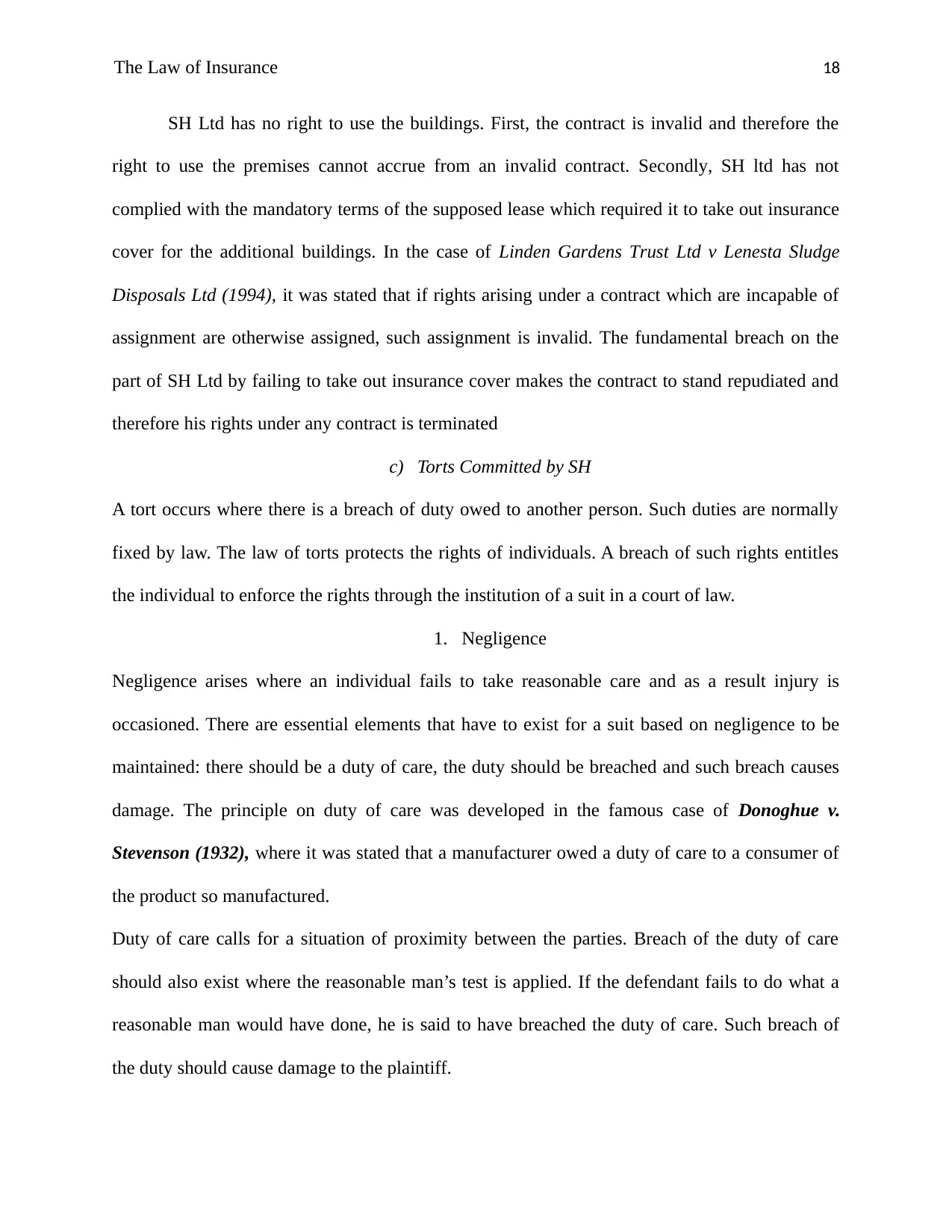
The Law of Insurance 18
SH Ltd has no right to use the buildings. First, the contract is invalid and therefore the
right to use the premises cannot accrue from an invalid contract. Secondly, SH ltd has not
complied with the mandatory terms of the supposed lease which required it to take out insurance
cover for the additional buildings. In the case of Linden Gardens Trust Ltd v Lenesta Sludge
Disposals Ltd (1994), it was stated that if rights arising under a contract which are incapable of
assignment are otherwise assigned, such assignment is invalid. The fundamental breach on the
part of SH Ltd by failing to take out insurance cover makes the contract to stand repudiated and
therefore his rights under any contract is terminated
c) Torts Committed by SH
A tort occurs where there is a breach of duty owed to another person. Such duties are normally
fixed by law. The law of torts protects the rights of individuals. A breach of such rights entitles
the individual to enforce the rights through the institution of a suit in a court of law.
1. Negligence
Negligence arises where an individual fails to take reasonable care and as a result injury is
occasioned. There are essential elements that have to exist for a suit based on negligence to be
maintained: there should be a duty of care, the duty should be breached and such breach causes
damage. The principle on duty of care was developed in the famous case of Donoghue v.
Stevenson (1932), where it was stated that a manufacturer owed a duty of care to a consumer of
the product so manufactured.
Duty of care calls for a situation of proximity between the parties. Breach of the duty of care
should also exist where the reasonable man’s test is applied. If the defendant fails to do what a
reasonable man would have done, he is said to have breached the duty of care. Such breach of
the duty should cause damage to the plaintiff.
SH Ltd has no right to use the buildings. First, the contract is invalid and therefore the
right to use the premises cannot accrue from an invalid contract. Secondly, SH ltd has not
complied with the mandatory terms of the supposed lease which required it to take out insurance
cover for the additional buildings. In the case of Linden Gardens Trust Ltd v Lenesta Sludge
Disposals Ltd (1994), it was stated that if rights arising under a contract which are incapable of
assignment are otherwise assigned, such assignment is invalid. The fundamental breach on the
part of SH Ltd by failing to take out insurance cover makes the contract to stand repudiated and
therefore his rights under any contract is terminated
c) Torts Committed by SH
A tort occurs where there is a breach of duty owed to another person. Such duties are normally
fixed by law. The law of torts protects the rights of individuals. A breach of such rights entitles
the individual to enforce the rights through the institution of a suit in a court of law.
1. Negligence
Negligence arises where an individual fails to take reasonable care and as a result injury is
occasioned. There are essential elements that have to exist for a suit based on negligence to be
maintained: there should be a duty of care, the duty should be breached and such breach causes
damage. The principle on duty of care was developed in the famous case of Donoghue v.
Stevenson (1932), where it was stated that a manufacturer owed a duty of care to a consumer of
the product so manufactured.
Duty of care calls for a situation of proximity between the parties. Breach of the duty of care
should also exist where the reasonable man’s test is applied. If the defendant fails to do what a
reasonable man would have done, he is said to have breached the duty of care. Such breach of
the duty should cause damage to the plaintiff.
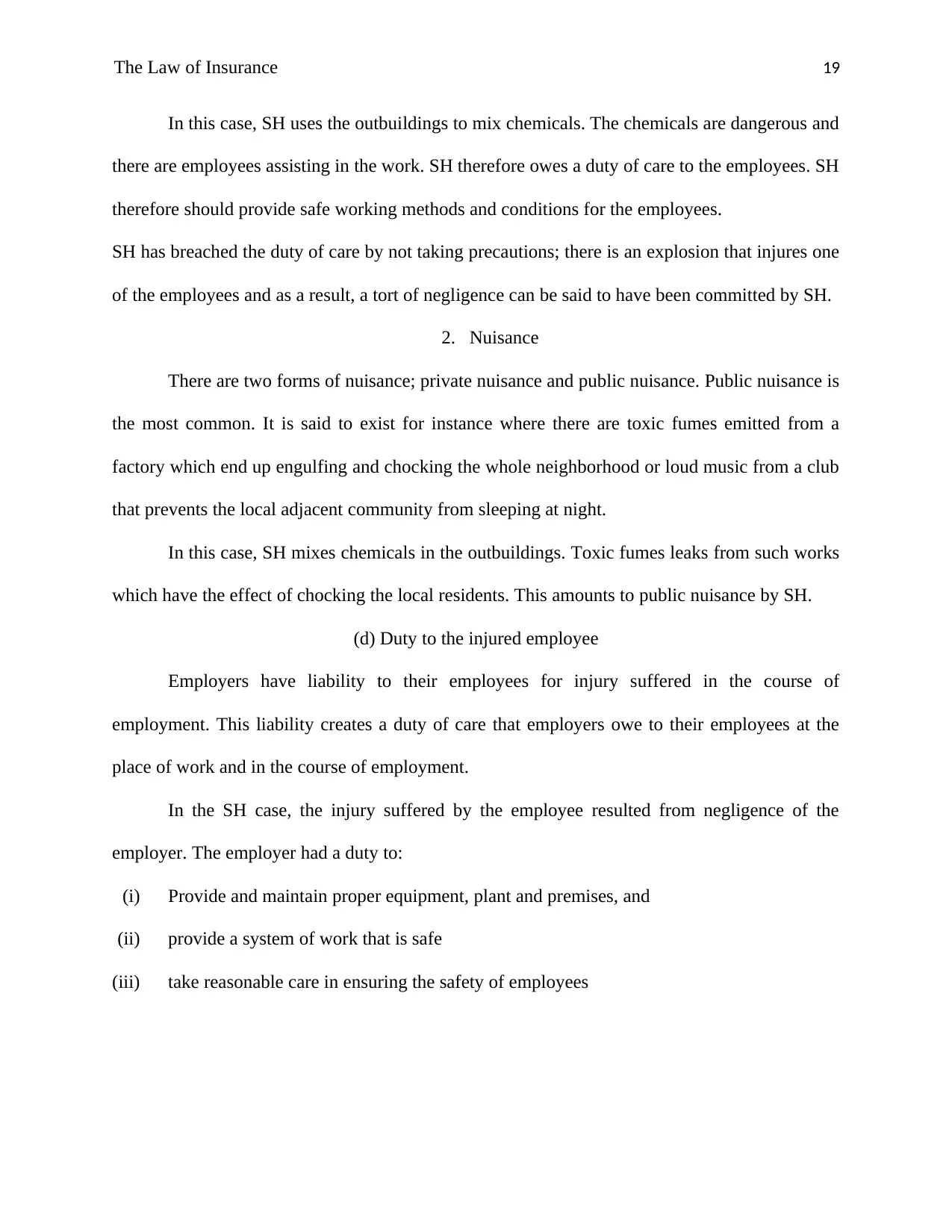
The Law of Insurance 19
In this case, SH uses the outbuildings to mix chemicals. The chemicals are dangerous and
there are employees assisting in the work. SH therefore owes a duty of care to the employees. SH
therefore should provide safe working methods and conditions for the employees.
SH has breached the duty of care by not taking precautions; there is an explosion that injures one
of the employees and as a result, a tort of negligence can be said to have been committed by SH.
2. Nuisance
There are two forms of nuisance; private nuisance and public nuisance. Public nuisance is
the most common. It is said to exist for instance where there are toxic fumes emitted from a
factory which end up engulfing and chocking the whole neighborhood or loud music from a club
that prevents the local adjacent community from sleeping at night.
In this case, SH mixes chemicals in the outbuildings. Toxic fumes leaks from such works
which have the effect of chocking the local residents. This amounts to public nuisance by SH.
(d) Duty to the injured employee
Employers have liability to their employees for injury suffered in the course of
employment. This liability creates a duty of care that employers owe to their employees at the
place of work and in the course of employment.
In the SH case, the injury suffered by the employee resulted from negligence of the
employer. The employer had a duty to:
(i) Provide and maintain proper equipment, plant and premises, and
(ii) provide a system of work that is safe
(iii) take reasonable care in ensuring the safety of employees
In this case, SH uses the outbuildings to mix chemicals. The chemicals are dangerous and
there are employees assisting in the work. SH therefore owes a duty of care to the employees. SH
therefore should provide safe working methods and conditions for the employees.
SH has breached the duty of care by not taking precautions; there is an explosion that injures one
of the employees and as a result, a tort of negligence can be said to have been committed by SH.
2. Nuisance
There are two forms of nuisance; private nuisance and public nuisance. Public nuisance is
the most common. It is said to exist for instance where there are toxic fumes emitted from a
factory which end up engulfing and chocking the whole neighborhood or loud music from a club
that prevents the local adjacent community from sleeping at night.
In this case, SH mixes chemicals in the outbuildings. Toxic fumes leaks from such works
which have the effect of chocking the local residents. This amounts to public nuisance by SH.
(d) Duty to the injured employee
Employers have liability to their employees for injury suffered in the course of
employment. This liability creates a duty of care that employers owe to their employees at the
place of work and in the course of employment.
In the SH case, the injury suffered by the employee resulted from negligence of the
employer. The employer had a duty to:
(i) Provide and maintain proper equipment, plant and premises, and
(ii) provide a system of work that is safe
(iii) take reasonable care in ensuring the safety of employees
Paraphrase This Document
Need a fresh take? Get an instant paraphrase of this document with our AI Paraphraser
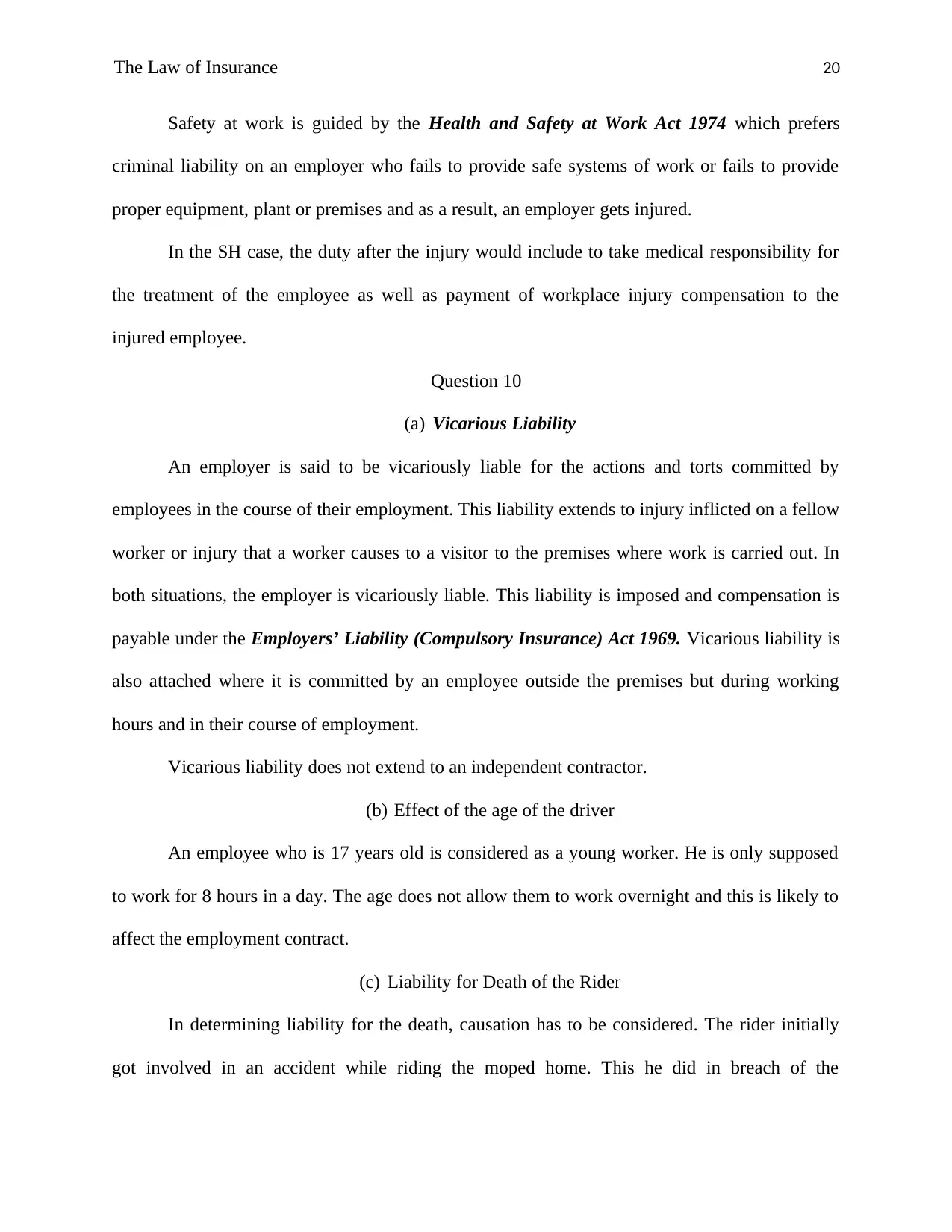
The Law of Insurance 20
Safety at work is guided by the Health and Safety at Work Act 1974 which prefers
criminal liability on an employer who fails to provide safe systems of work or fails to provide
proper equipment, plant or premises and as a result, an employer gets injured.
In the SH case, the duty after the injury would include to take medical responsibility for
the treatment of the employee as well as payment of workplace injury compensation to the
injured employee.
Question 10
(a) Vicarious Liability
An employer is said to be vicariously liable for the actions and torts committed by
employees in the course of their employment. This liability extends to injury inflicted on a fellow
worker or injury that a worker causes to a visitor to the premises where work is carried out. In
both situations, the employer is vicariously liable. This liability is imposed and compensation is
payable under the Employers’ Liability (Compulsory Insurance) Act 1969. Vicarious liability is
also attached where it is committed by an employee outside the premises but during working
hours and in their course of employment.
Vicarious liability does not extend to an independent contractor.
(b) Effect of the age of the driver
An employee who is 17 years old is considered as a young worker. He is only supposed
to work for 8 hours in a day. The age does not allow them to work overnight and this is likely to
affect the employment contract.
(c) Liability for Death of the Rider
In determining liability for the death, causation has to be considered. The rider initially
got involved in an accident while riding the moped home. This he did in breach of the
Safety at work is guided by the Health and Safety at Work Act 1974 which prefers
criminal liability on an employer who fails to provide safe systems of work or fails to provide
proper equipment, plant or premises and as a result, an employer gets injured.
In the SH case, the duty after the injury would include to take medical responsibility for
the treatment of the employee as well as payment of workplace injury compensation to the
injured employee.
Question 10
(a) Vicarious Liability
An employer is said to be vicariously liable for the actions and torts committed by
employees in the course of their employment. This liability extends to injury inflicted on a fellow
worker or injury that a worker causes to a visitor to the premises where work is carried out. In
both situations, the employer is vicariously liable. This liability is imposed and compensation is
payable under the Employers’ Liability (Compulsory Insurance) Act 1969. Vicarious liability is
also attached where it is committed by an employee outside the premises but during working
hours and in their course of employment.
Vicarious liability does not extend to an independent contractor.
(b) Effect of the age of the driver
An employee who is 17 years old is considered as a young worker. He is only supposed
to work for 8 hours in a day. The age does not allow them to work overnight and this is likely to
affect the employment contract.
(c) Liability for Death of the Rider
In determining liability for the death, causation has to be considered. The rider initially
got involved in an accident while riding the moped home. This he did in breach of the
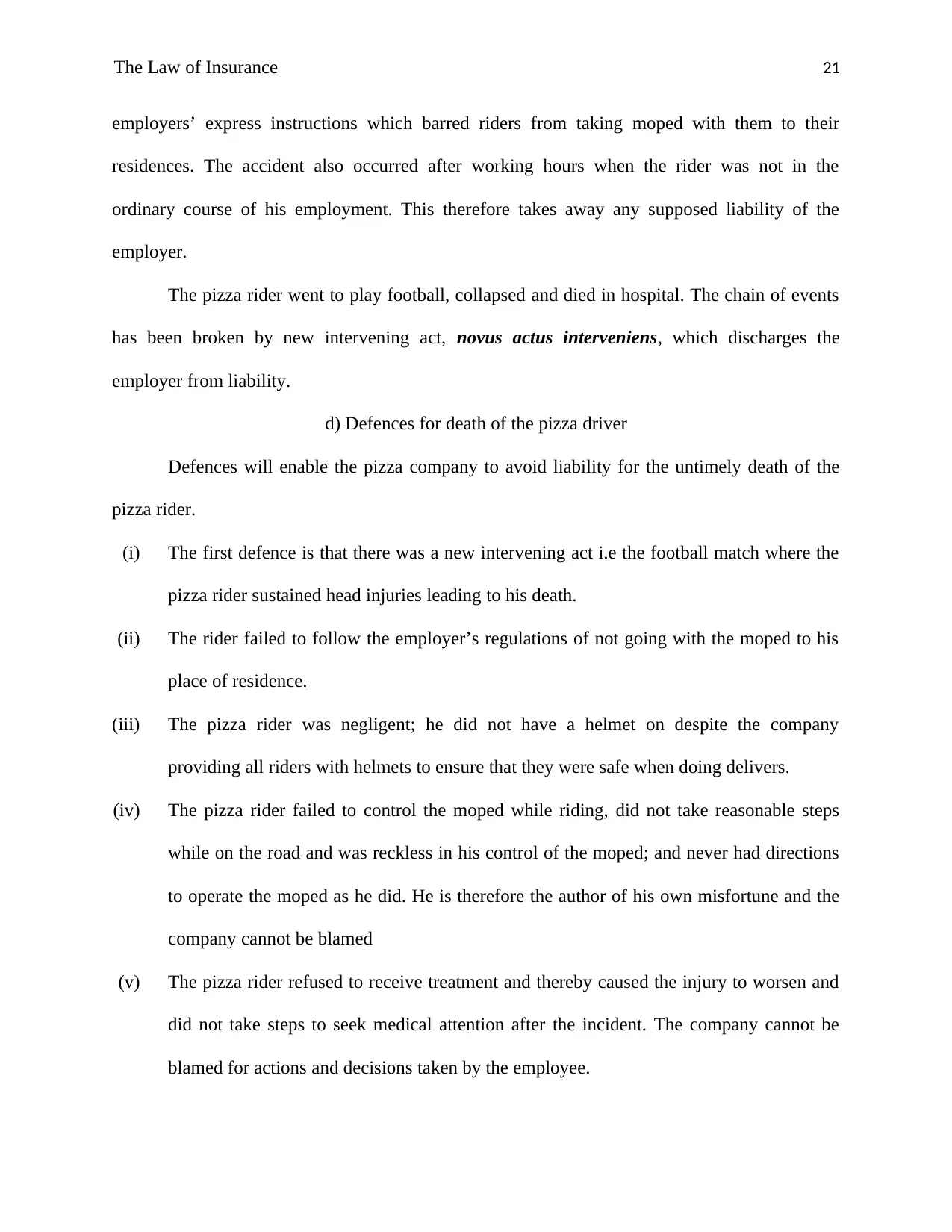
The Law of Insurance 21
employers’ express instructions which barred riders from taking moped with them to their
residences. The accident also occurred after working hours when the rider was not in the
ordinary course of his employment. This therefore takes away any supposed liability of the
employer.
The pizza rider went to play football, collapsed and died in hospital. The chain of events
has been broken by new intervening act, novus actus interveniens, which discharges the
employer from liability.
d) Defences for death of the pizza driver
Defences will enable the pizza company to avoid liability for the untimely death of the
pizza rider.
(i) The first defence is that there was a new intervening act i.e the football match where the
pizza rider sustained head injuries leading to his death.
(ii) The rider failed to follow the employer’s regulations of not going with the moped to his
place of residence.
(iii) The pizza rider was negligent; he did not have a helmet on despite the company
providing all riders with helmets to ensure that they were safe when doing delivers.
(iv) The pizza rider failed to control the moped while riding, did not take reasonable steps
while on the road and was reckless in his control of the moped; and never had directions
to operate the moped as he did. He is therefore the author of his own misfortune and the
company cannot be blamed
(v) The pizza rider refused to receive treatment and thereby caused the injury to worsen and
did not take steps to seek medical attention after the incident. The company cannot be
blamed for actions and decisions taken by the employee.
employers’ express instructions which barred riders from taking moped with them to their
residences. The accident also occurred after working hours when the rider was not in the
ordinary course of his employment. This therefore takes away any supposed liability of the
employer.
The pizza rider went to play football, collapsed and died in hospital. The chain of events
has been broken by new intervening act, novus actus interveniens, which discharges the
employer from liability.
d) Defences for death of the pizza driver
Defences will enable the pizza company to avoid liability for the untimely death of the
pizza rider.
(i) The first defence is that there was a new intervening act i.e the football match where the
pizza rider sustained head injuries leading to his death.
(ii) The rider failed to follow the employer’s regulations of not going with the moped to his
place of residence.
(iii) The pizza rider was negligent; he did not have a helmet on despite the company
providing all riders with helmets to ensure that they were safe when doing delivers.
(iv) The pizza rider failed to control the moped while riding, did not take reasonable steps
while on the road and was reckless in his control of the moped; and never had directions
to operate the moped as he did. He is therefore the author of his own misfortune and the
company cannot be blamed
(v) The pizza rider refused to receive treatment and thereby caused the injury to worsen and
did not take steps to seek medical attention after the incident. The company cannot be
blamed for actions and decisions taken by the employee.
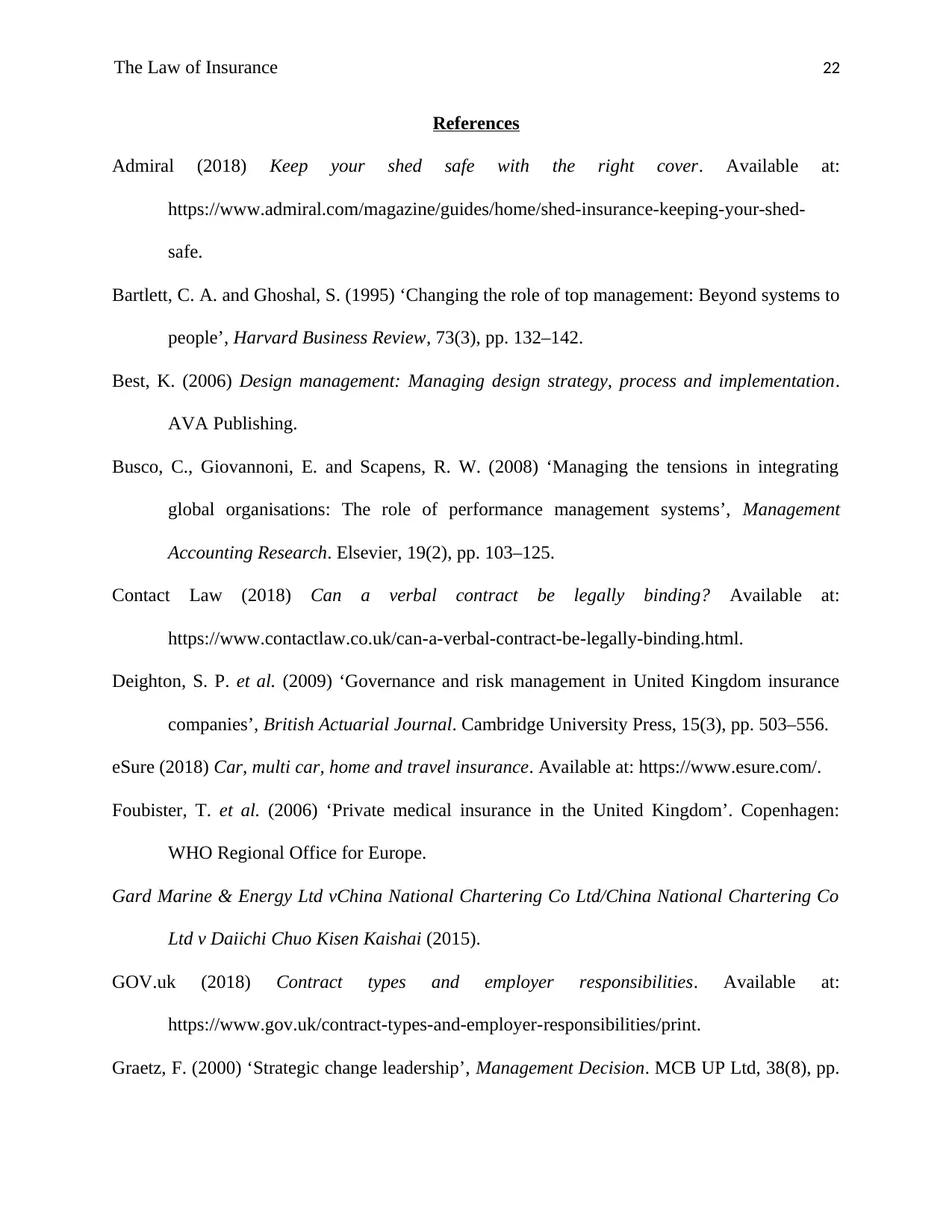
The Law of Insurance 22
References
Admiral (2018) Keep your shed safe with the right cover. Available at:
https://www.admiral.com/magazine/guides/home/shed-insurance-keeping-your-shed-
safe.
Bartlett, C. A. and Ghoshal, S. (1995) ‘Changing the role of top management: Beyond systems to
people’, Harvard Business Review, 73(3), pp. 132–142.
Best, K. (2006) Design management: Managing design strategy, process and implementation.
AVA Publishing.
Busco, C., Giovannoni, E. and Scapens, R. W. (2008) ‘Managing the tensions in integrating
global organisations: The role of performance management systems’, Management
Accounting Research. Elsevier, 19(2), pp. 103–125.
Contact Law (2018) Can a verbal contract be legally binding? Available at:
https://www.contactlaw.co.uk/can-a-verbal-contract-be-legally-binding.html.
Deighton, S. P. et al. (2009) ‘Governance and risk management in United Kingdom insurance
companies’, British Actuarial Journal. Cambridge University Press, 15(3), pp. 503–556.
eSure (2018) Car, multi car, home and travel insurance. Available at: https://www.esure.com/.
Foubister, T. et al. (2006) ‘Private medical insurance in the United Kingdom’. Copenhagen:
WHO Regional Office for Europe.
Gard Marine & Energy Ltd vChina National Chartering Co Ltd/China National Chartering Co
Ltd v Daiichi Chuo Kisen Kaishai (2015).
GOV.uk (2018) Contract types and employer responsibilities. Available at:
https://www.gov.uk/contract-types-and-employer-responsibilities/print.
Graetz, F. (2000) ‘Strategic change leadership’, Management Decision. MCB UP Ltd, 38(8), pp.
References
Admiral (2018) Keep your shed safe with the right cover. Available at:
https://www.admiral.com/magazine/guides/home/shed-insurance-keeping-your-shed-
safe.
Bartlett, C. A. and Ghoshal, S. (1995) ‘Changing the role of top management: Beyond systems to
people’, Harvard Business Review, 73(3), pp. 132–142.
Best, K. (2006) Design management: Managing design strategy, process and implementation.
AVA Publishing.
Busco, C., Giovannoni, E. and Scapens, R. W. (2008) ‘Managing the tensions in integrating
global organisations: The role of performance management systems’, Management
Accounting Research. Elsevier, 19(2), pp. 103–125.
Contact Law (2018) Can a verbal contract be legally binding? Available at:
https://www.contactlaw.co.uk/can-a-verbal-contract-be-legally-binding.html.
Deighton, S. P. et al. (2009) ‘Governance and risk management in United Kingdom insurance
companies’, British Actuarial Journal. Cambridge University Press, 15(3), pp. 503–556.
eSure (2018) Car, multi car, home and travel insurance. Available at: https://www.esure.com/.
Foubister, T. et al. (2006) ‘Private medical insurance in the United Kingdom’. Copenhagen:
WHO Regional Office for Europe.
Gard Marine & Energy Ltd vChina National Chartering Co Ltd/China National Chartering Co
Ltd v Daiichi Chuo Kisen Kaishai (2015).
GOV.uk (2018) Contract types and employer responsibilities. Available at:
https://www.gov.uk/contract-types-and-employer-responsibilities/print.
Graetz, F. (2000) ‘Strategic change leadership’, Management Decision. MCB UP Ltd, 38(8), pp.
Secure Best Marks with AI Grader
Need help grading? Try our AI Grader for instant feedback on your assignments.
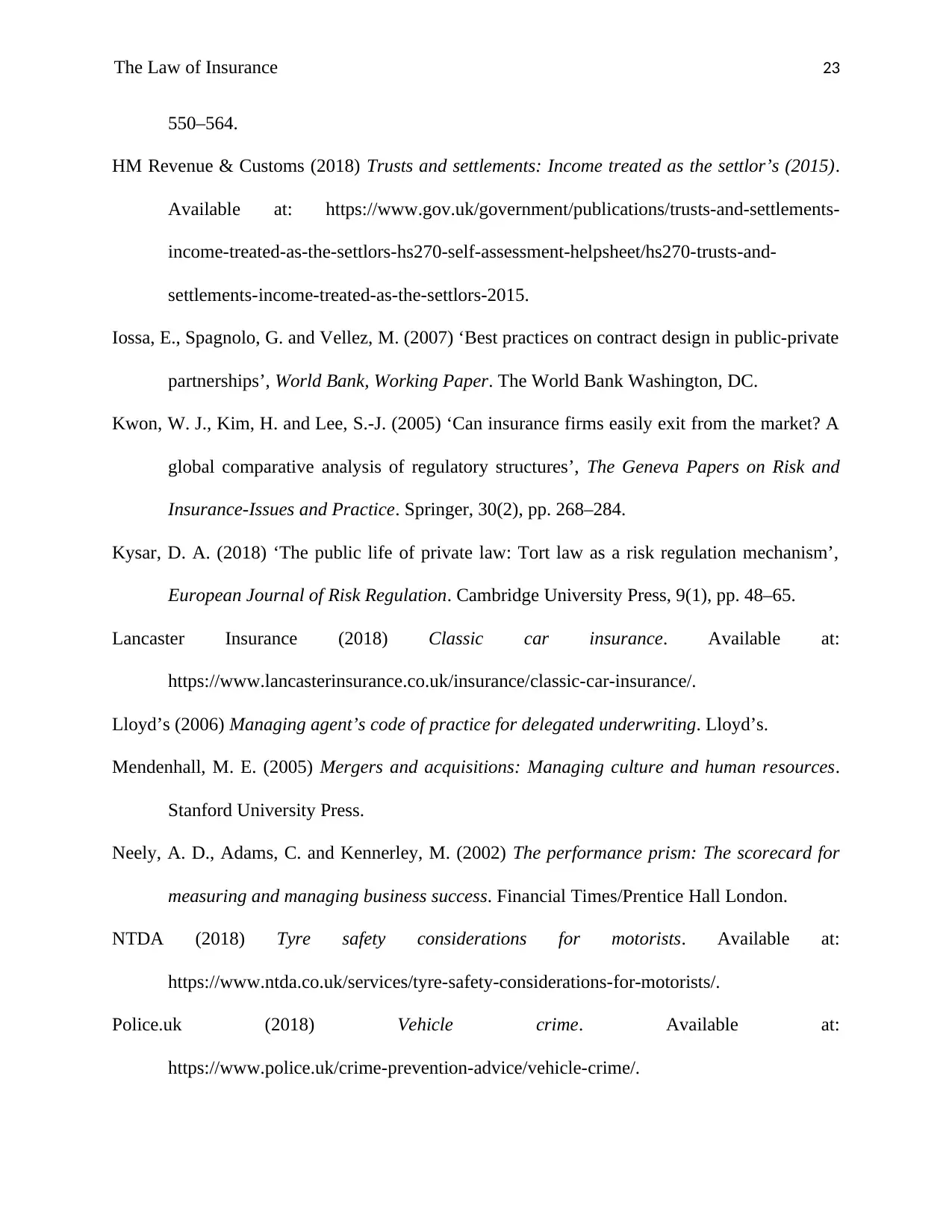
The Law of Insurance 23
550–564.
HM Revenue & Customs (2018) Trusts and settlements: Income treated as the settlor’s (2015).
Available at: https://www.gov.uk/government/publications/trusts-and-settlements-
income-treated-as-the-settlors-hs270-self-assessment-helpsheet/hs270-trusts-and-
settlements-income-treated-as-the-settlors-2015.
Iossa, E., Spagnolo, G. and Vellez, M. (2007) ‘Best practices on contract design in public-private
partnerships’, World Bank, Working Paper. The World Bank Washington, DC.
Kwon, W. J., Kim, H. and Lee, S.-J. (2005) ‘Can insurance firms easily exit from the market? A
global comparative analysis of regulatory structures’, The Geneva Papers on Risk and
Insurance-Issues and Practice. Springer, 30(2), pp. 268–284.
Kysar, D. A. (2018) ‘The public life of private law: Tort law as a risk regulation mechanism’,
European Journal of Risk Regulation. Cambridge University Press, 9(1), pp. 48–65.
Lancaster Insurance (2018) Classic car insurance. Available at:
https://www.lancasterinsurance.co.uk/insurance/classic-car-insurance/.
Lloyd’s (2006) Managing agent’s code of practice for delegated underwriting. Lloyd’s.
Mendenhall, M. E. (2005) Mergers and acquisitions: Managing culture and human resources.
Stanford University Press.
Neely, A. D., Adams, C. and Kennerley, M. (2002) The performance prism: The scorecard for
measuring and managing business success. Financial Times/Prentice Hall London.
NTDA (2018) Tyre safety considerations for motorists. Available at:
https://www.ntda.co.uk/services/tyre-safety-considerations-for-motorists/.
Police.uk (2018) Vehicle crime. Available at:
https://www.police.uk/crime-prevention-advice/vehicle-crime/.
550–564.
HM Revenue & Customs (2018) Trusts and settlements: Income treated as the settlor’s (2015).
Available at: https://www.gov.uk/government/publications/trusts-and-settlements-
income-treated-as-the-settlors-hs270-self-assessment-helpsheet/hs270-trusts-and-
settlements-income-treated-as-the-settlors-2015.
Iossa, E., Spagnolo, G. and Vellez, M. (2007) ‘Best practices on contract design in public-private
partnerships’, World Bank, Working Paper. The World Bank Washington, DC.
Kwon, W. J., Kim, H. and Lee, S.-J. (2005) ‘Can insurance firms easily exit from the market? A
global comparative analysis of regulatory structures’, The Geneva Papers on Risk and
Insurance-Issues and Practice. Springer, 30(2), pp. 268–284.
Kysar, D. A. (2018) ‘The public life of private law: Tort law as a risk regulation mechanism’,
European Journal of Risk Regulation. Cambridge University Press, 9(1), pp. 48–65.
Lancaster Insurance (2018) Classic car insurance. Available at:
https://www.lancasterinsurance.co.uk/insurance/classic-car-insurance/.
Lloyd’s (2006) Managing agent’s code of practice for delegated underwriting. Lloyd’s.
Mendenhall, M. E. (2005) Mergers and acquisitions: Managing culture and human resources.
Stanford University Press.
Neely, A. D., Adams, C. and Kennerley, M. (2002) The performance prism: The scorecard for
measuring and managing business success. Financial Times/Prentice Hall London.
NTDA (2018) Tyre safety considerations for motorists. Available at:
https://www.ntda.co.uk/services/tyre-safety-considerations-for-motorists/.
Police.uk (2018) Vehicle crime. Available at:
https://www.police.uk/crime-prevention-advice/vehicle-crime/.
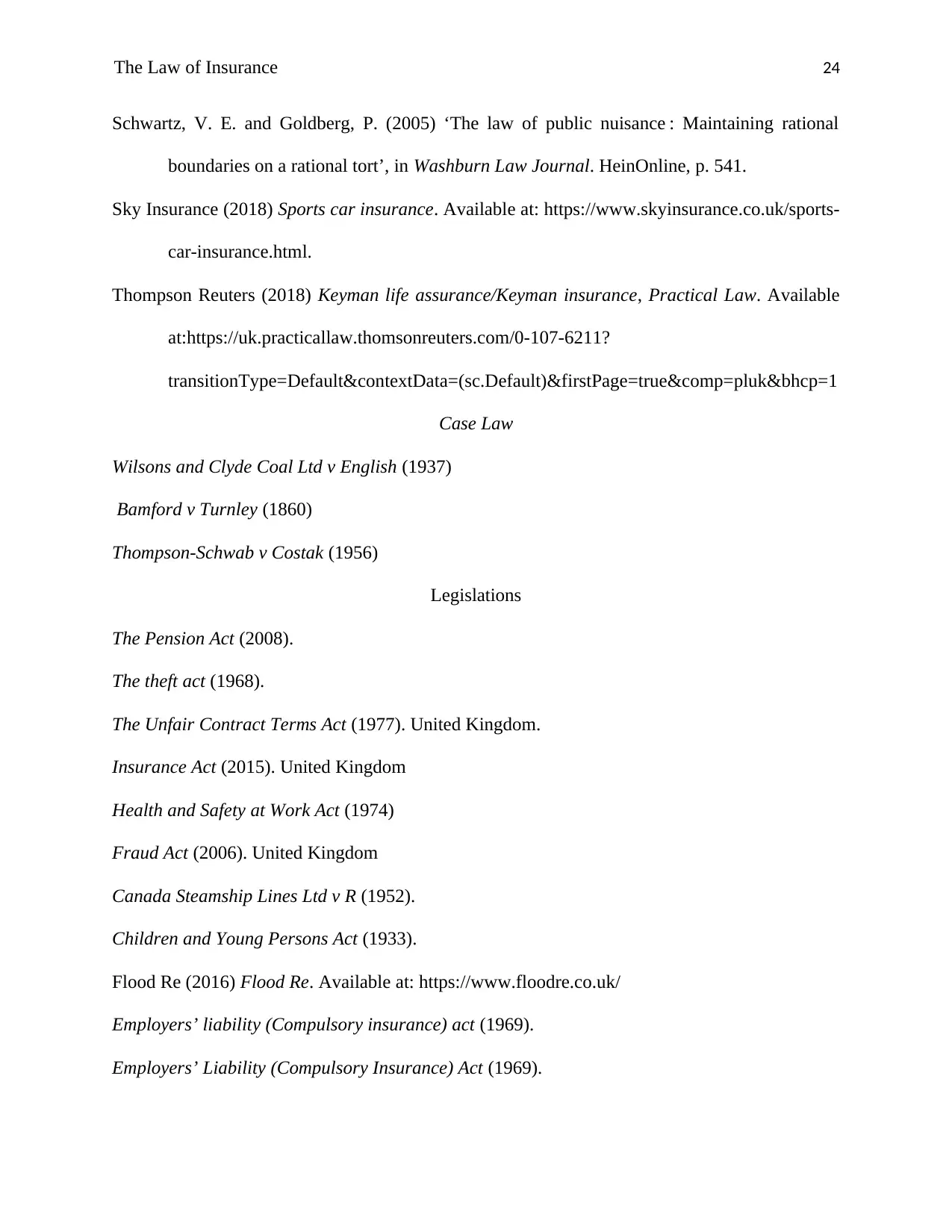
The Law of Insurance 24
Schwartz, V. E. and Goldberg, P. (2005) ‘The law of public nuisance : Maintaining rational
boundaries on a rational tort’, in Washburn Law Journal. HeinOnline, p. 541.
Sky Insurance (2018) Sports car insurance. Available at: https://www.skyinsurance.co.uk/sports-
car-insurance.html.
Thompson Reuters (2018) Keyman life assurance/Keyman insurance, Practical Law. Available
at:https://uk.practicallaw.thomsonreuters.com/0-107-6211?
transitionType=Default&contextData=(sc.Default)&firstPage=true&comp=pluk&bhcp=1
Case Law
Wilsons and Clyde Coal Ltd v English (1937)
Bamford v Turnley (1860)
Thompson-Schwab v Costak (1956)
Legislations
The Pension Act (2008).
The theft act (1968).
The Unfair Contract Terms Act (1977). United Kingdom.
Insurance Act (2015). United Kingdom
Health and Safety at Work Act (1974)
Fraud Act (2006). United Kingdom
Canada Steamship Lines Ltd v R (1952).
Children and Young Persons Act (1933).
Flood Re (2016) Flood Re. Available at: https://www.floodre.co.uk/
Employers’ liability (Compulsory insurance) act (1969).
Employers’ Liability (Compulsory Insurance) Act (1969).
Schwartz, V. E. and Goldberg, P. (2005) ‘The law of public nuisance : Maintaining rational
boundaries on a rational tort’, in Washburn Law Journal. HeinOnline, p. 541.
Sky Insurance (2018) Sports car insurance. Available at: https://www.skyinsurance.co.uk/sports-
car-insurance.html.
Thompson Reuters (2018) Keyman life assurance/Keyman insurance, Practical Law. Available
at:https://uk.practicallaw.thomsonreuters.com/0-107-6211?
transitionType=Default&contextData=(sc.Default)&firstPage=true&comp=pluk&bhcp=1
Case Law
Wilsons and Clyde Coal Ltd v English (1937)
Bamford v Turnley (1860)
Thompson-Schwab v Costak (1956)
Legislations
The Pension Act (2008).
The theft act (1968).
The Unfair Contract Terms Act (1977). United Kingdom.
Insurance Act (2015). United Kingdom
Health and Safety at Work Act (1974)
Fraud Act (2006). United Kingdom
Canada Steamship Lines Ltd v R (1952).
Children and Young Persons Act (1933).
Flood Re (2016) Flood Re. Available at: https://www.floodre.co.uk/
Employers’ liability (Compulsory insurance) act (1969).
Employers’ Liability (Compulsory Insurance) Act (1969).
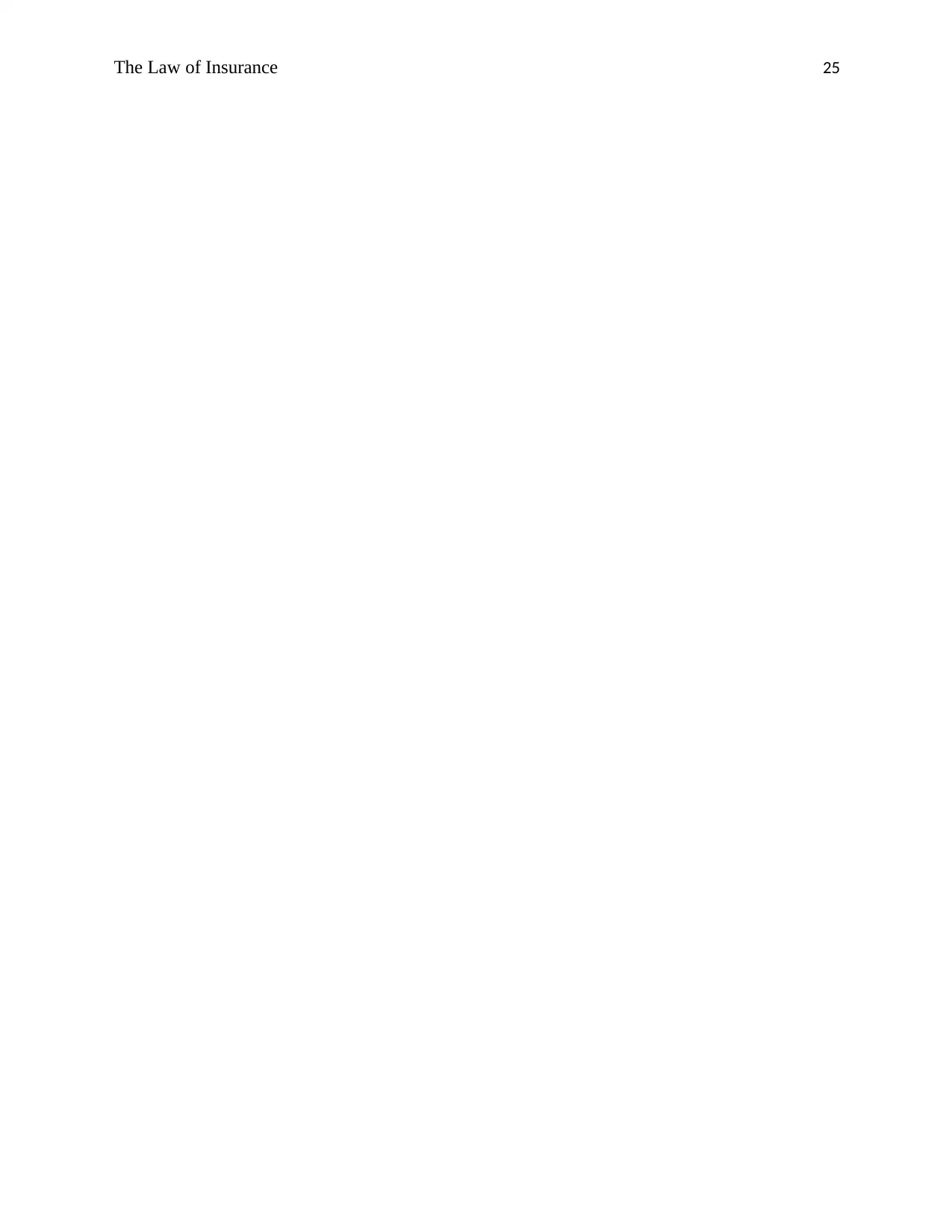
The Law of Insurance 25
1 out of 25
Related Documents
Your All-in-One AI-Powered Toolkit for Academic Success.
+13062052269
info@desklib.com
Available 24*7 on WhatsApp / Email
![[object Object]](/_next/static/media/star-bottom.7253800d.svg)
Unlock your academic potential
© 2024 | Zucol Services PVT LTD | All rights reserved.




